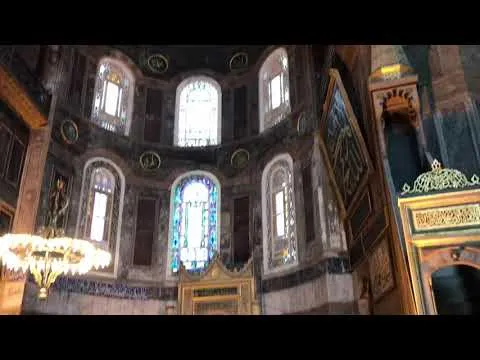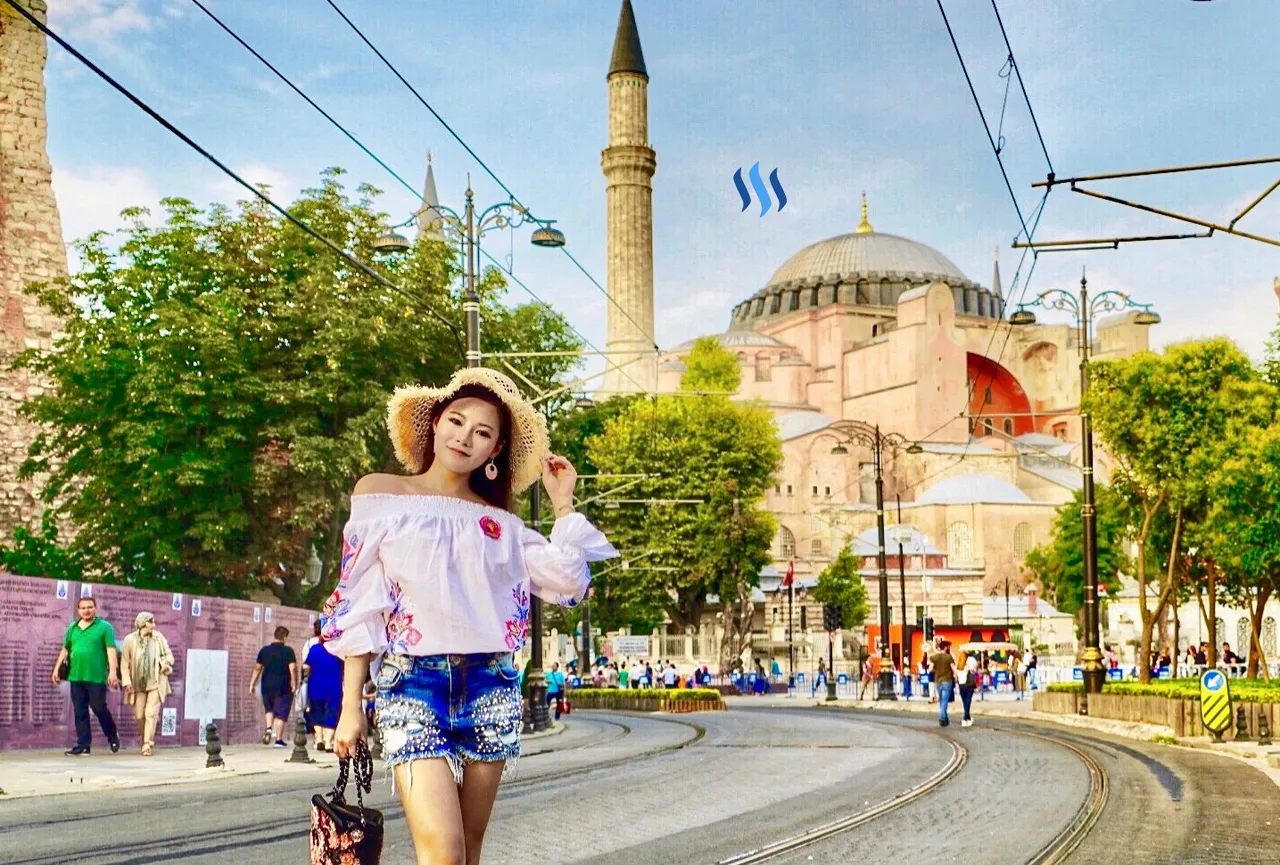
Dear Steemit Friends:
Welcome to another blog post of mine! I can't wait to connect with all of you and hope you really enjoy what I have in store for you today. You'll not believe just how amazing the landmark is that we are going to explore together. Located in Istanbul in Turkey, this iconic building has to be seen to be believed. I really hope that my photography can help you experience this beautiful landmark the same way that I did.
What is this amazing place called? Hagia Sophia. Stay right to the end to see it as you've never experienced it before!
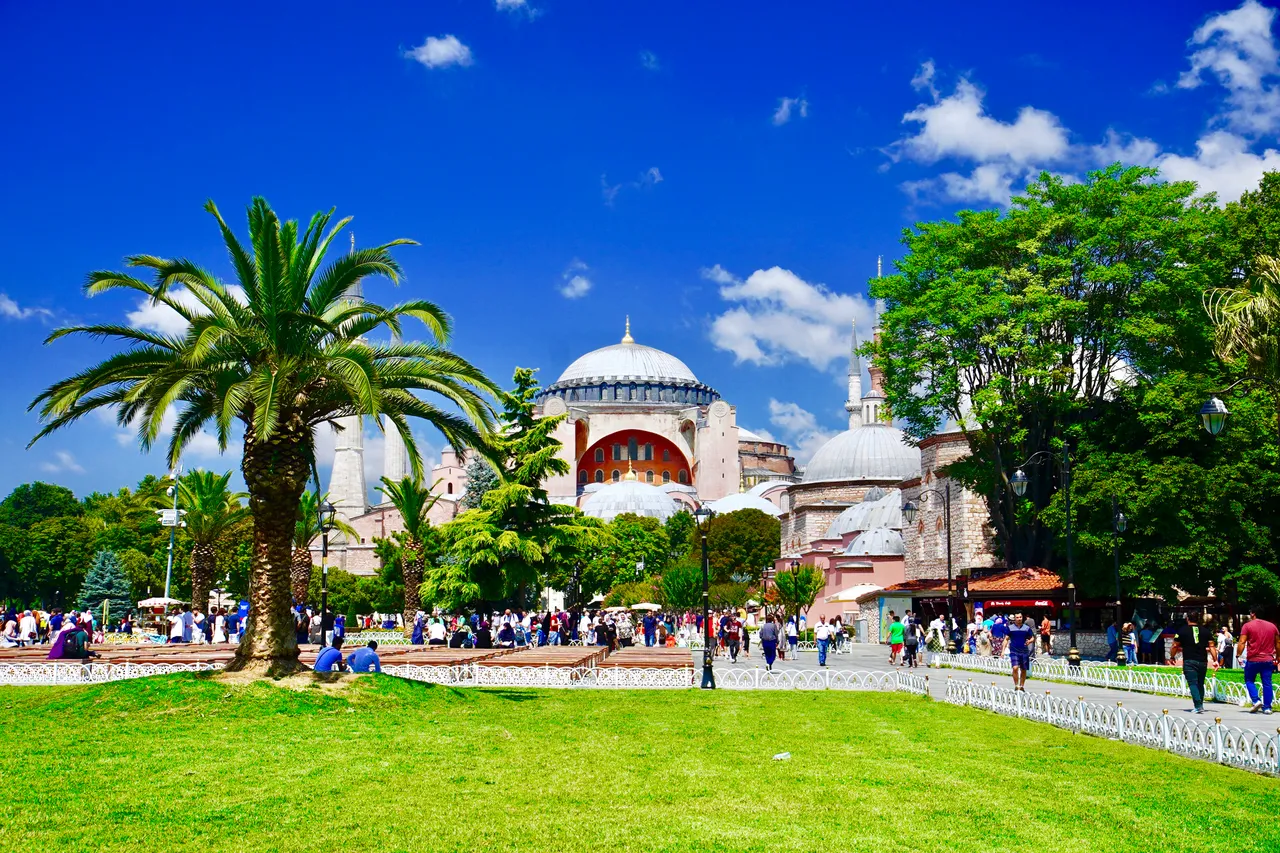
Right next to the Blue Mosque that we saw in my last post, the imposing Hagia Sophia has a long, rich and colourful history. 'Hagia Sophia' is derived from the Greek for Holy Wisdom, which reflects its roots as a Greek Orthodox Christian cathedral. First built in 537 AD, it was the largest building in the world at the time.
You can see has a very distinct dome shape, which was particularly unique at the time. Though we now see this dome shape often in Islamic architecture, this building style wasn't always as common. When first built, Hagia Sofia would have been truly unique. The dome shape only became widely synonymous with Muslim architecture during the Ottoman empire, when the Sultans realised that a unified religious architecture would help unify the empire. They chose the dome shape to be one of their iconic structural shapes and they are now founds all over the world where Muslims worship.
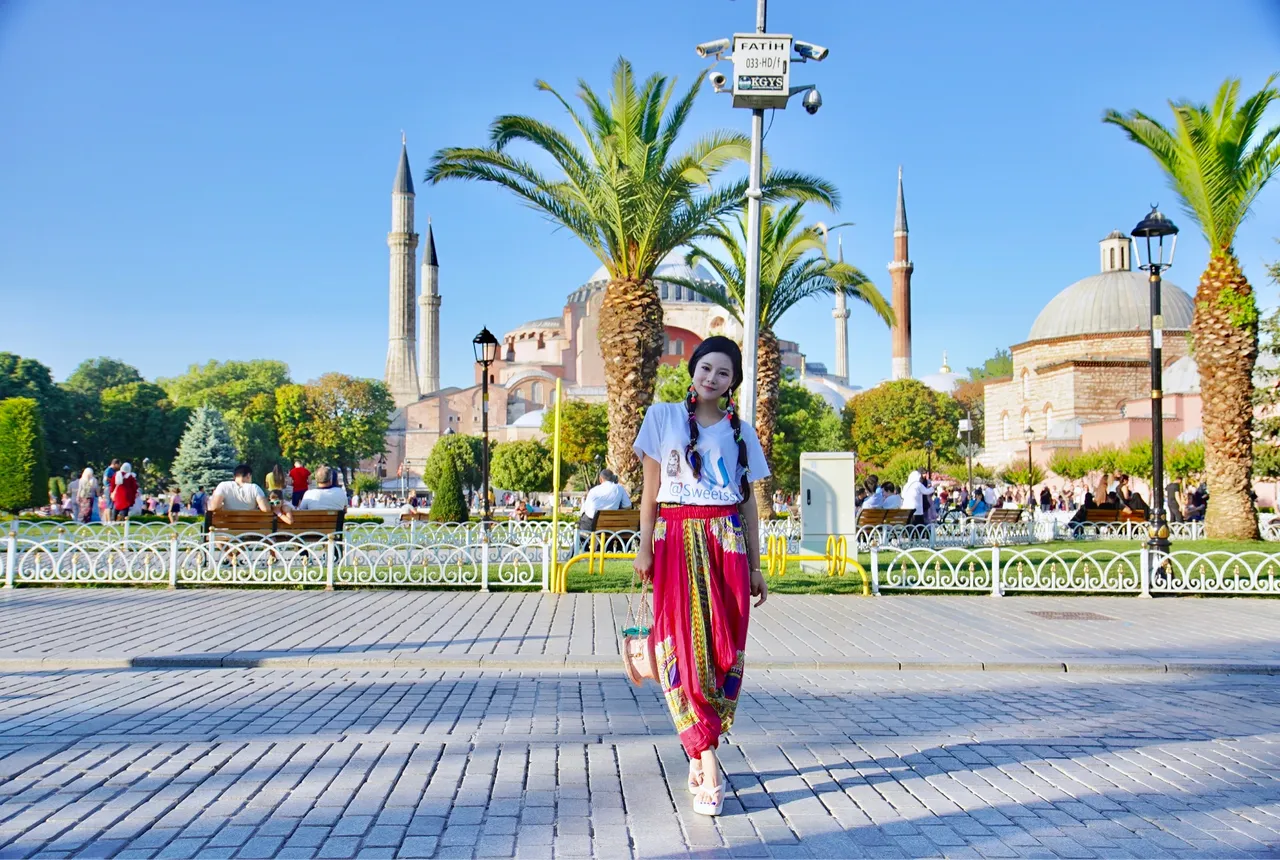
For 900 years Hagia Sophia was an orthodox cathedral and served as an important place of worship and religious governance until 1453 when it then became a mosque under the Ottoman empire. Amazingly, it is even larger than the Blue Mosque even though the mosque was built 1000 years later. It truly is a wonder of design and architecture for a building so old. It inspires and dominates the skyline even now, so in 537 AD it must have left those who visited it in complete awe.
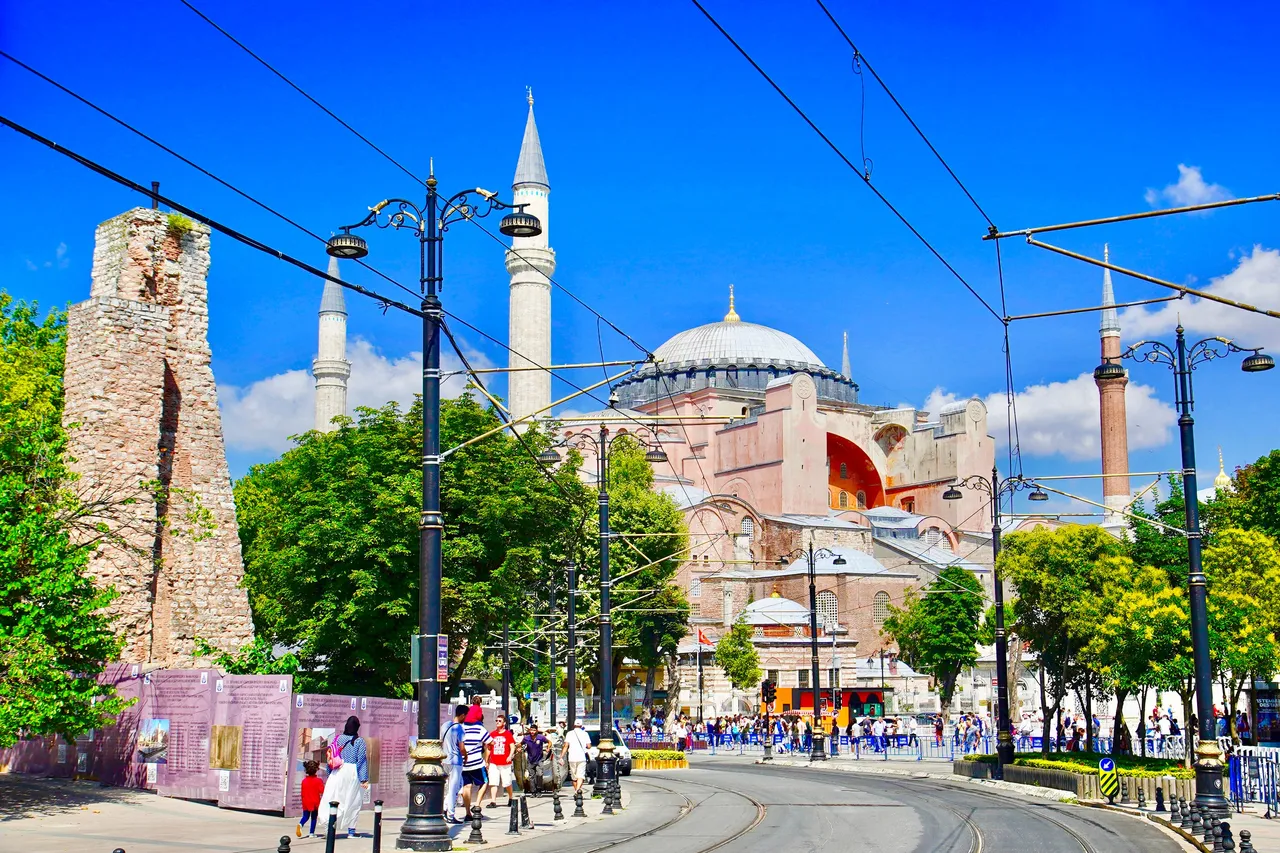
Hagia Sophia is mostly built from small bricks and mortal, which makes it look to me a bit more rustic than buildings cut from large stone blocks. A bit like someone started off wanting to build a house and then just forgot to stop building! It only took five years to build, and replaced another church on the same site. That church was constructed mostly of wood, and thus it burned down to the ground in 532 AD. Emperor Justinian the 1st immediately commissioned the construction of a new church on the site, which was to become Hafia Sophia as we know it today.
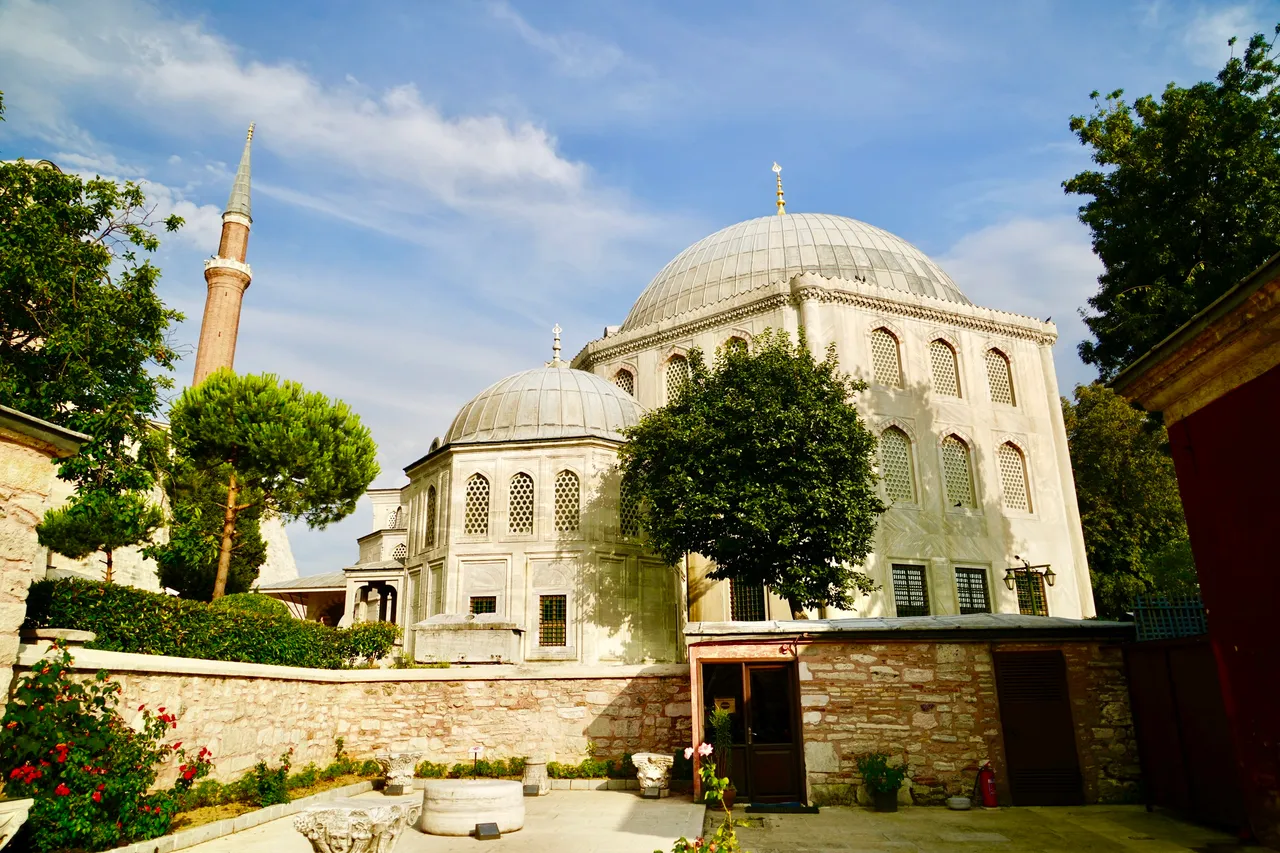
An amazing feat of engineering, historical records tell us that construction took over 10,000 workers to build. Unfortunately, only 35 years later the dome suffered damage after a major earthquake, and collapsed in 558. Historians believe the collapse was blamed on the dome being too 'flat'. The emperor commissioned an architect named Isidorus to fix the roof. He used lighter materials and increased the arch of the roof to create a stronger shape. This dome has now stood since 560 AD!
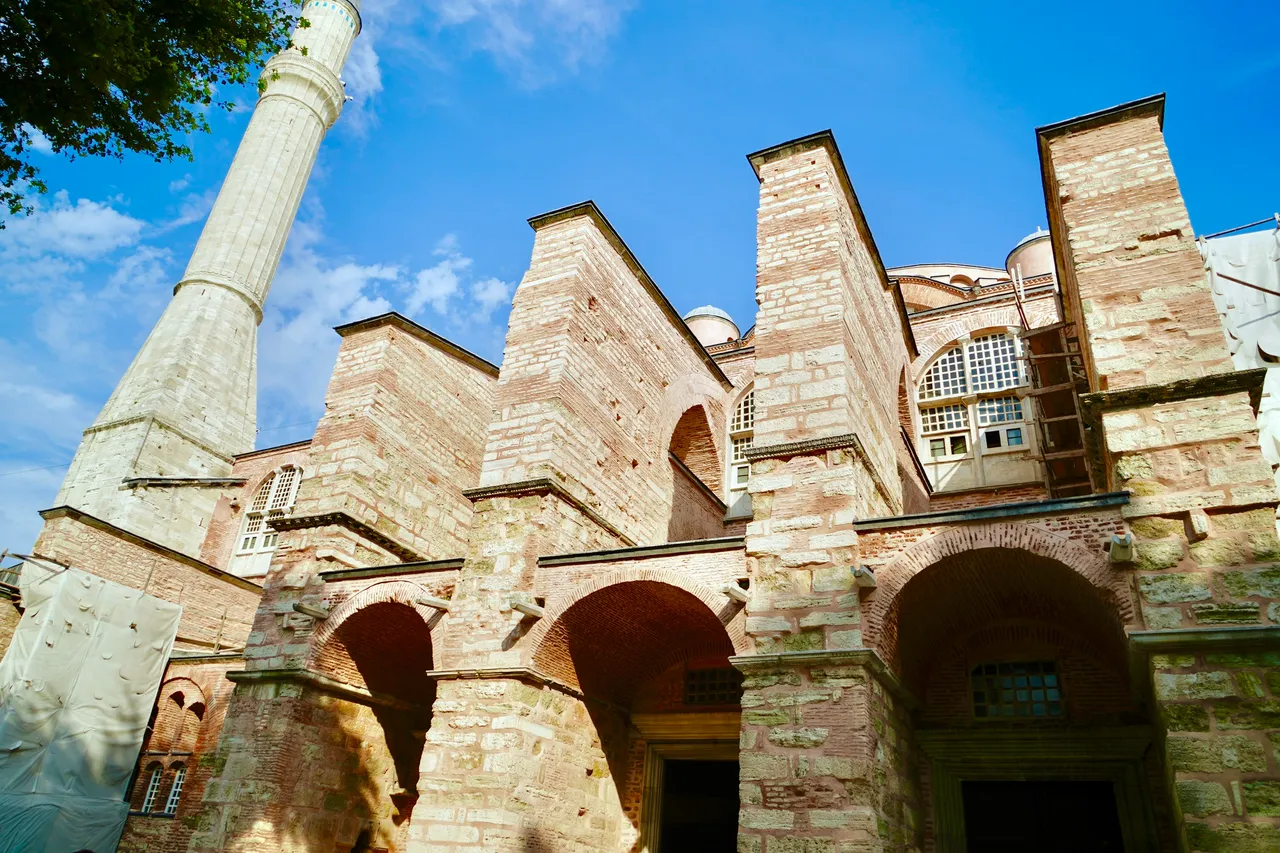
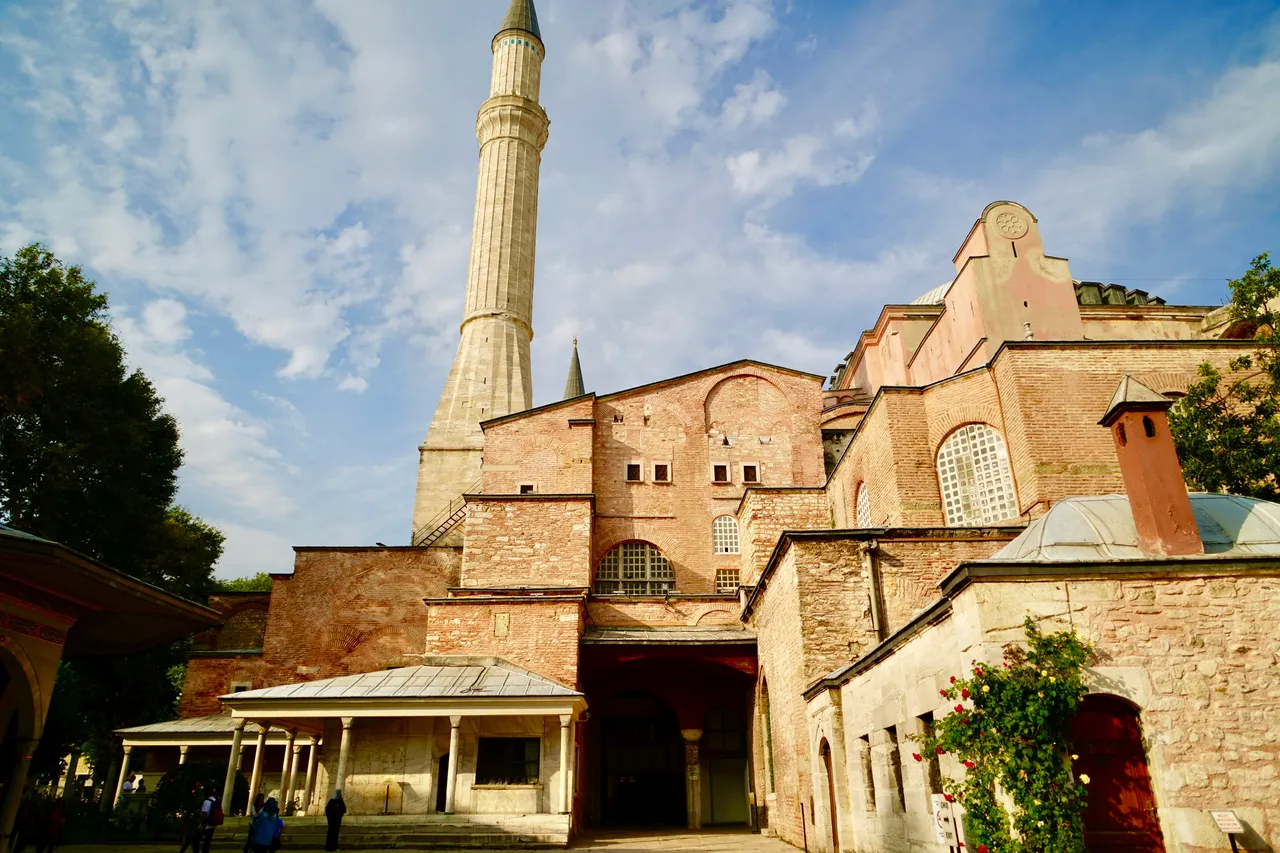
Hagia Sophia's 82m length and 73m width isn't just comprised of the main dome. There are also additional structures and buildings that make up the entire area. I found walking around the building, not just seeing the standard front view, to be fascinating.
Venturing inside the majestic domes of Hagia Sophia
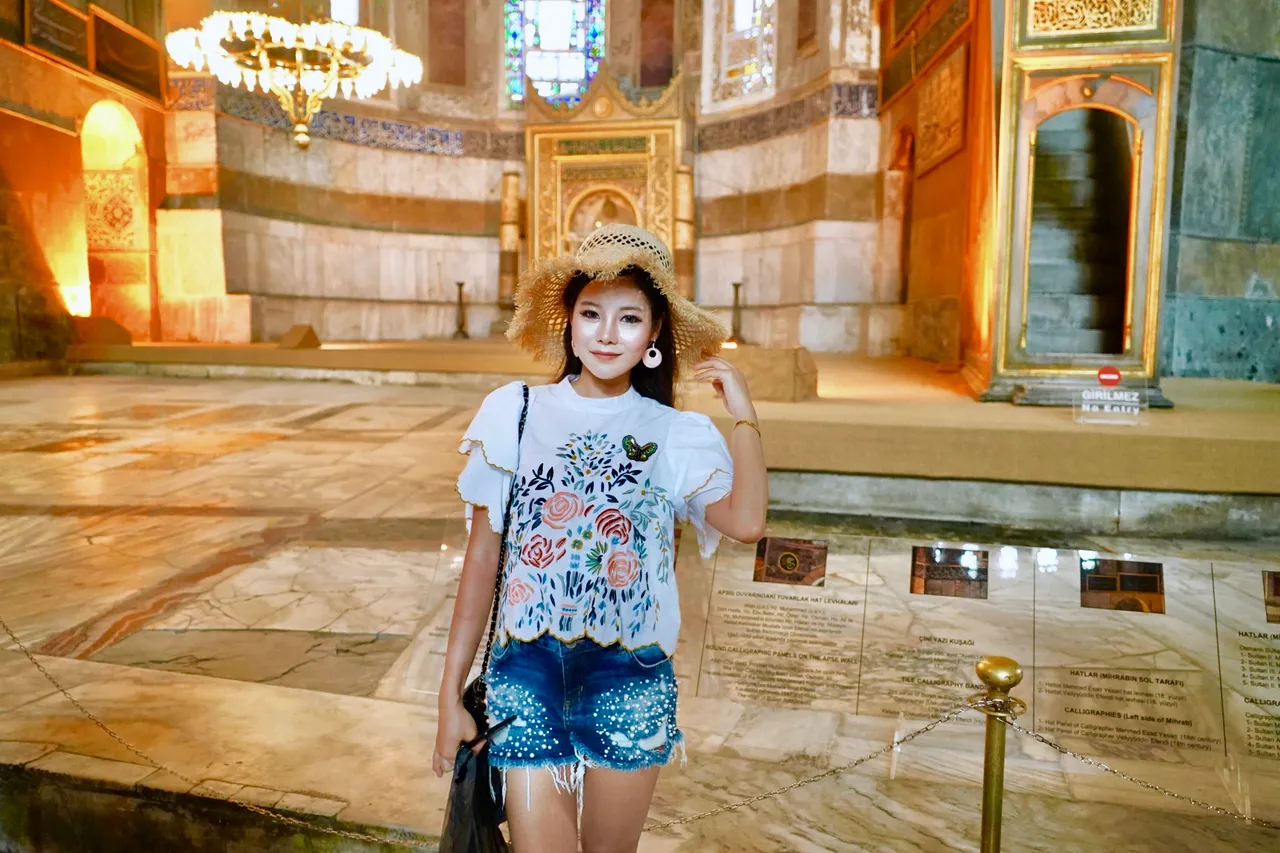
Venturing inside, I was as impressed with the beautiful interior as much as the exterior. The building is no longer a centre for religious activities as it has been for thousands of years - it is now a museum. This means that elements from both Christian and Muslim history have been preserved within, making it a fascinating place to explore.

I knew that Hagia Sofia was famous for its great columns and mosaics, but I don't think anything can prepare you for the scale and complexity of them. The vaulted dome ceilings, with the soaring columns, look more like the inside of a cathedral. However, that symbolism is then mixed in with many different elements from the Islamic history of the building. It makes for a truly unique mix of different designs found together in very few places in the world.
The gold on the mosaic in the vaulted dome above makes the ceiling seem to almost glow, shining a beautiful golden light down onto those of us standing below.
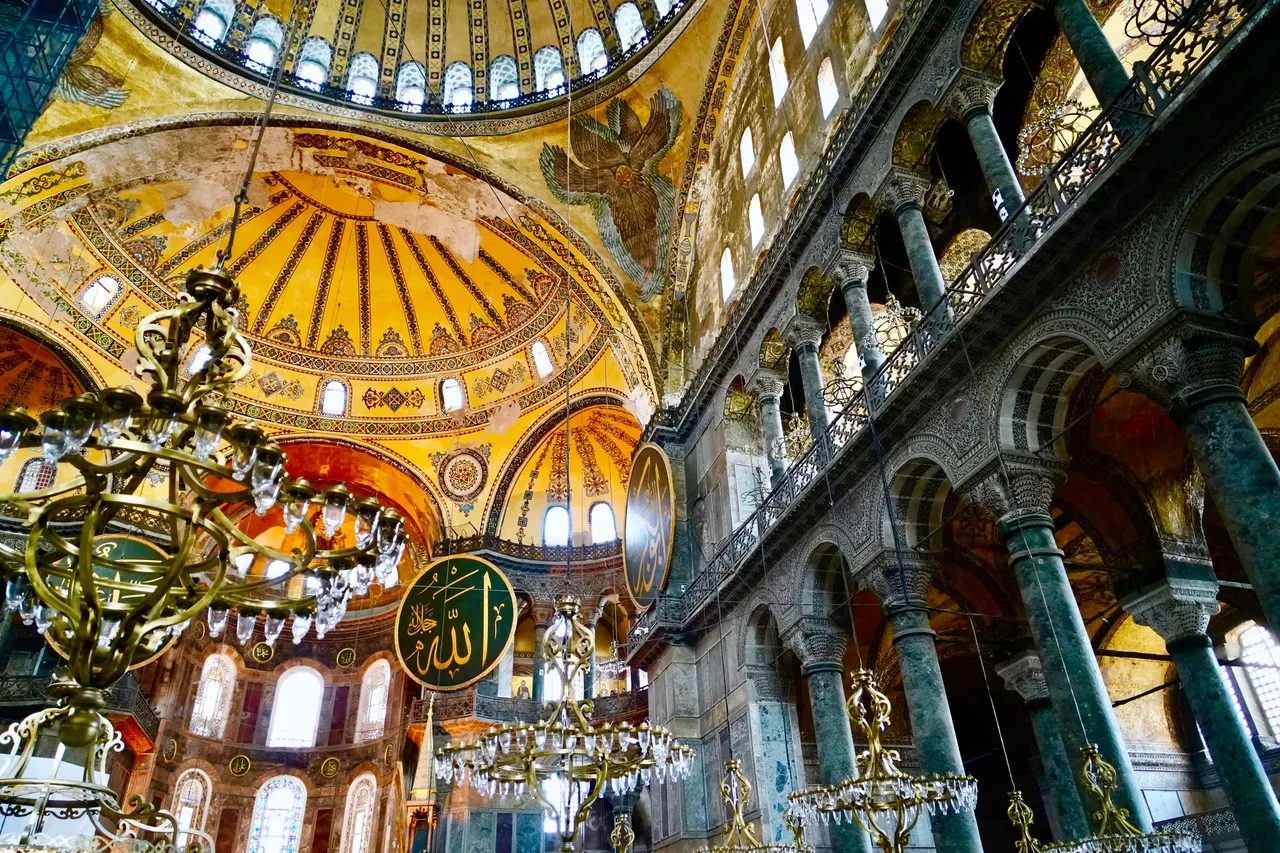
From the outside, the central dome dominates your focus. Inside, however, you realise that there are in fact multiple domes that interconnect. Each one is decorated different to the other, with gold colours and religious imagery being the most common colours and motifs. Holding up the massive ceiling are the beautifully stacked, carved and decorated columns. Standing under the 55m central dome, admiring the immensity of Hagia Sophia, I did feel very small and humbled.
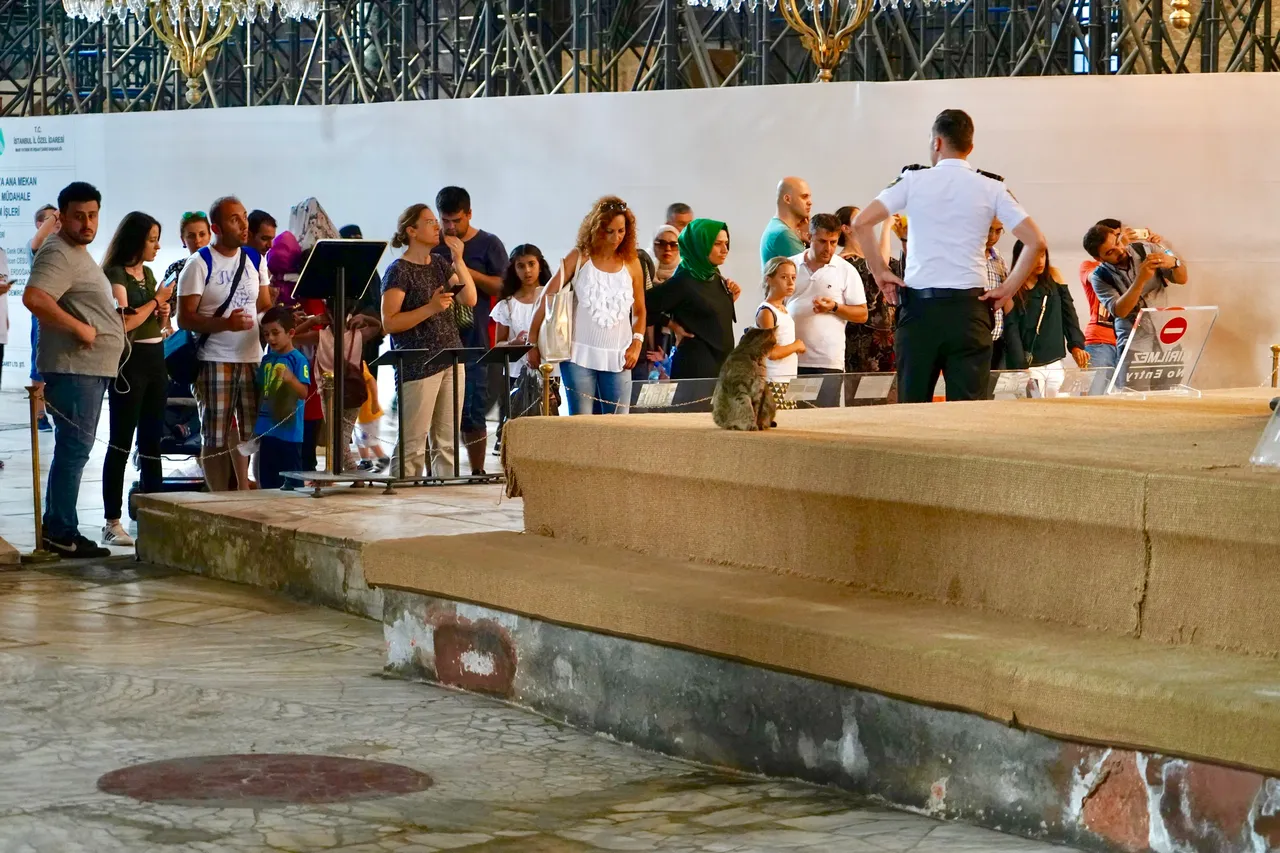
Stop! Look very carefully. I wasn't just taking photos of a bunch of random people... I found a fury friend, in the last place I'd have expected! Up at the front of the giant ex cathedral I noticed the cutest little cat. He looked like he had positioned himself in front of the crowd, ready to give a speech! Perhaps he is the caretaker of the building and wanted to address the gathered crowd about the proper conduct while visiting.
He looked completely un-concerned by his upcoming public address, but I thought I was worried he might run off if I approached him too quickly. I did hang back for a bit, my eyes drawn between wanting to admire the majestic domes and columns further, and wanting to go and meet The Caretaker. I decided that the building had already been standing for well over 1000 years, so it would probably still be there in a few minutes after I'd gone and made a new friend.
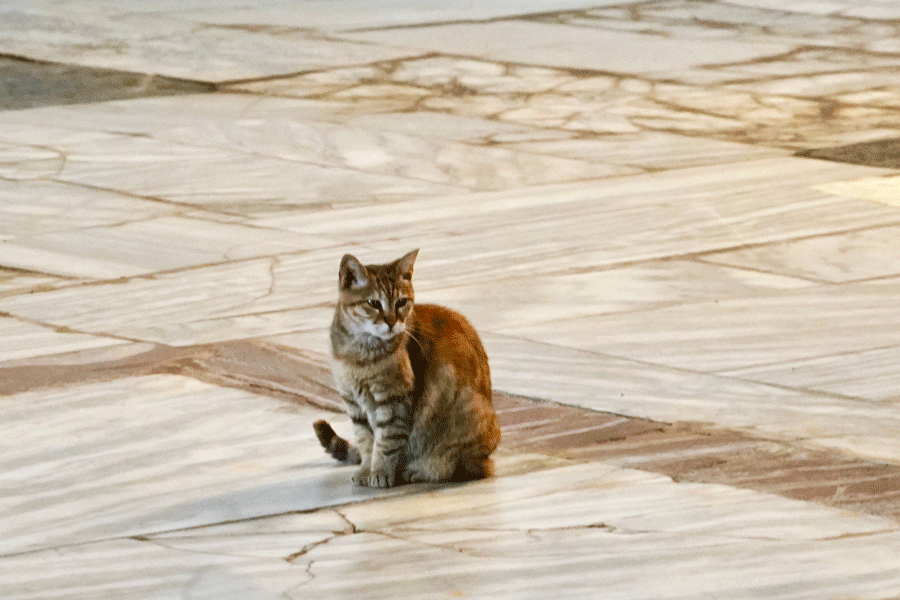
I got a little bit closer to 'The Caretaker', and after he had meowed his instructions to the waiting crowd, I wanted to go and meet him. He seemed like such a friendly little cat and I knew he must be quite used to visitors. I think he knew how cute he was as he was almost posing for the camera!
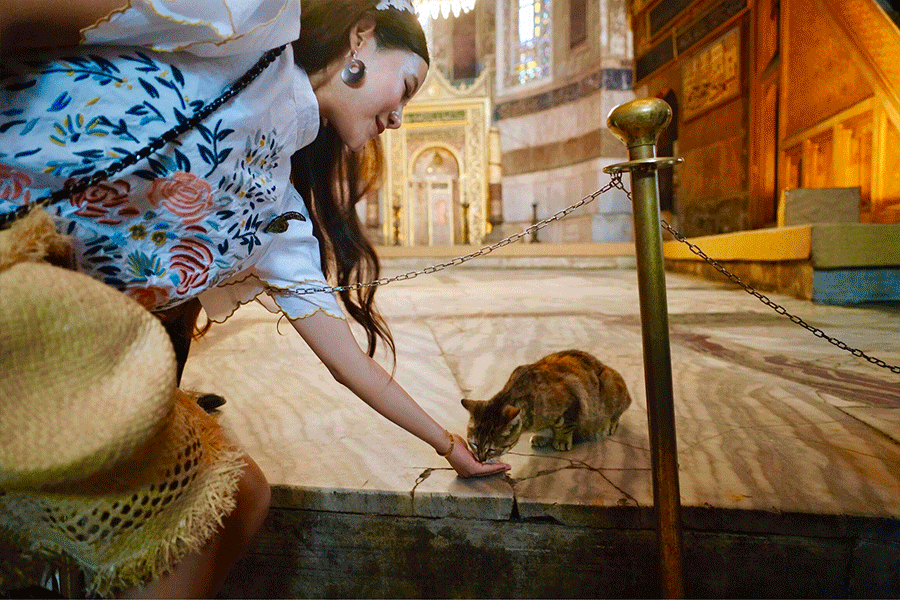
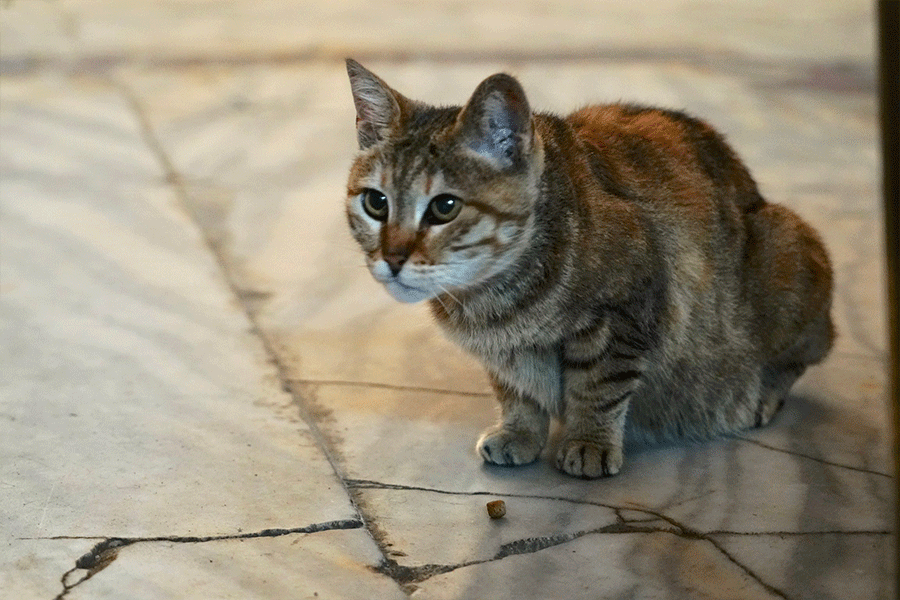
I loved making a new little furry friend. He must get looked after very well by tourists. As much as I joke about him being The Caretaker, I did wonder if he was a stray that just wanders into the building through some secret entrance each day, or if he belongs to the museum. He seemed completely un-phased by all of the people around him, though he was quite timid when coming to get food. Because of that I suspected that he was a stray, because he had 'street' instincts, but must have visited regularly. What a beautiful little man! So good to meet him. I knew he'd be supervising all of the tourists in Hagia Sophia and making sure we all enjoyed ourselves.
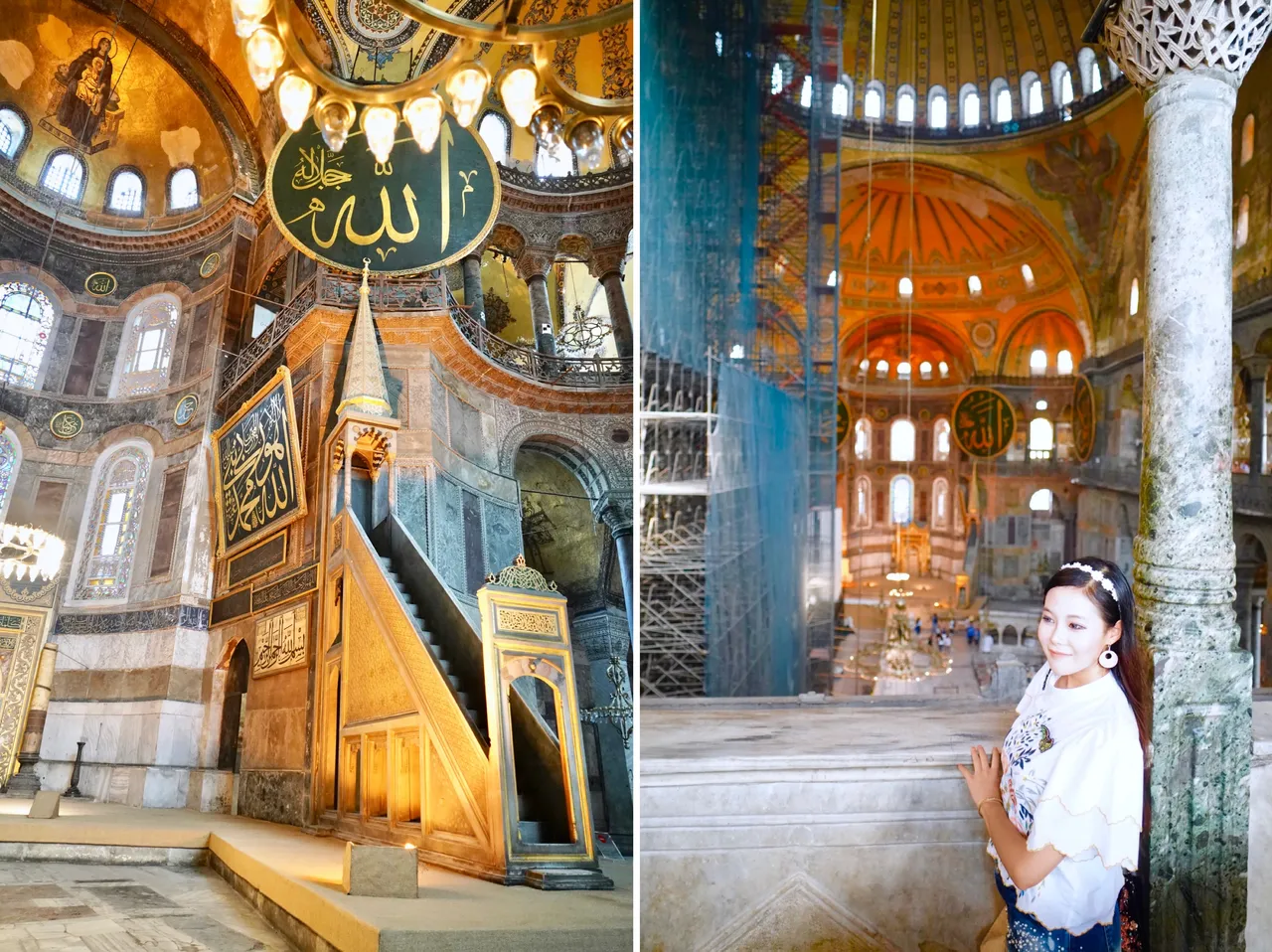
As you can see from the photo here, there was some pretty extensive restoration work going on during my visit. In such an old building it is essential that the structure is kept strong and safe for all of the visitors, and the preservation of such a landmark. This is especially important since the the history of Hagia Sophia is marked by regular earthquakes and earthquake damage. The building is a UNESCO world heritage site and has seen extensive renovations since receiving the prestigious status in 1993.
On top of that, there's the priceless art that adorns every surface of the building's walls and ceilings. Everything from the sun to damp to tourists can cause damage to these pieces of work. They could never be replaced so they must be restored. The museum does a great and unending job of maintaining the splendour of the building.
Let's take a closer look...
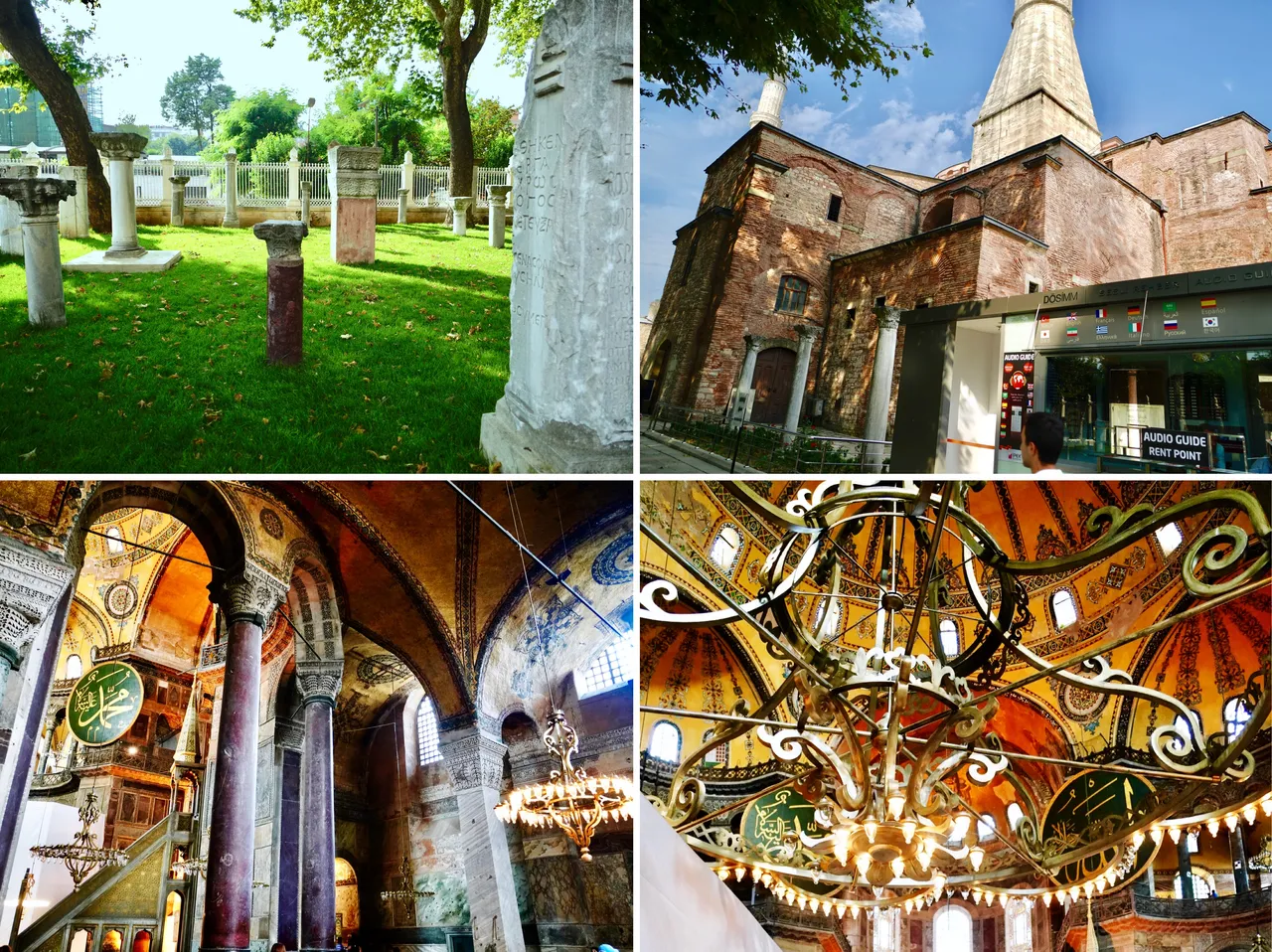
Within the walls of Hagia Sophia there is so much to see, all of which is extremely interesting and spectacular. In this section I want to take you on a little tour of all of the little details that I noticed within the museum to give you a better sense of the place. For example, look at these amazing chandeliers that are found suspended from the huge domed roofs, providing light and a sense of grandeur to the already majestic space.
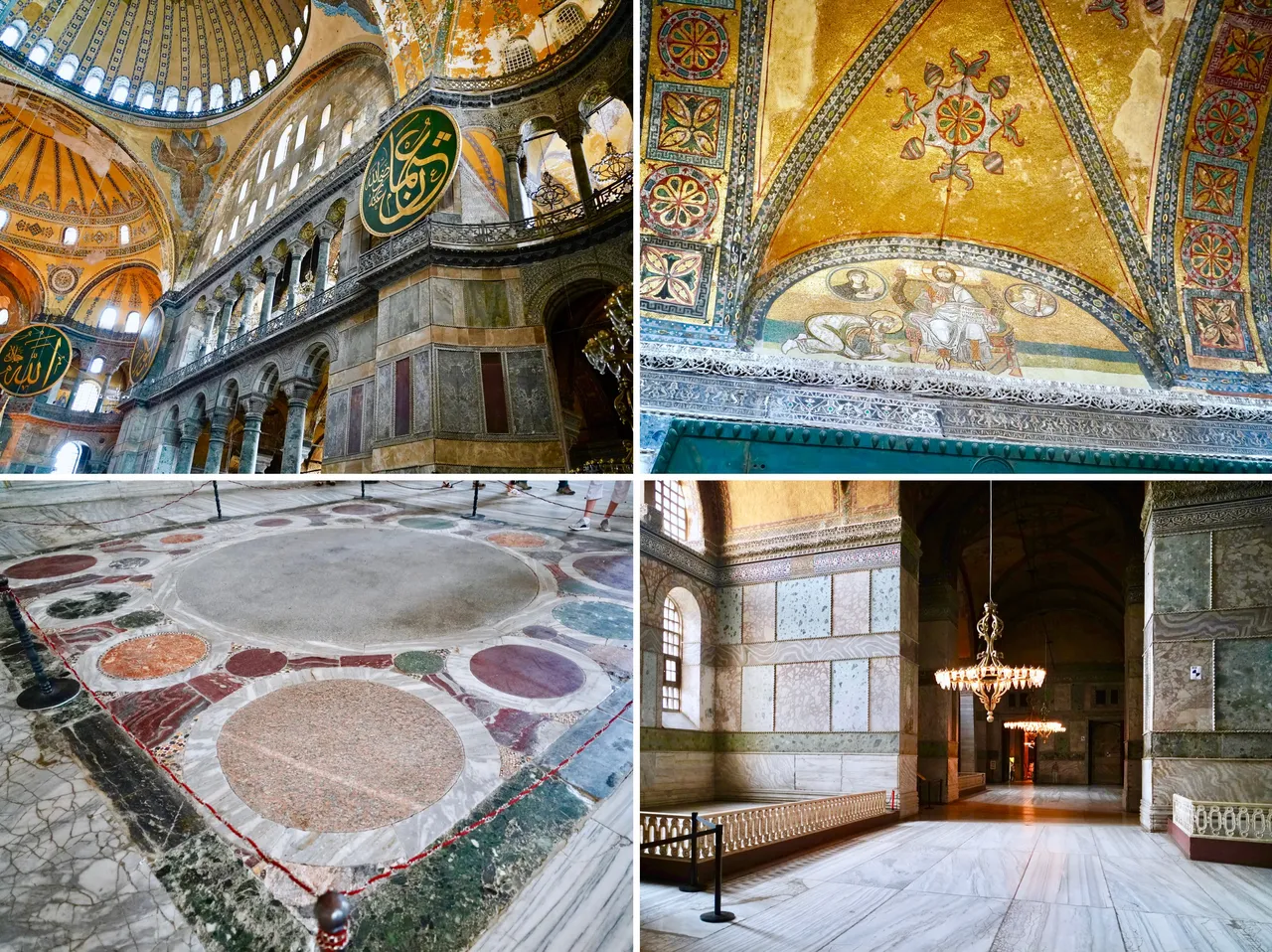
Some areas are so fragile that tourists can't go near them or walk on them because they could suffer damage or general wear overtime. I also wished I could have read what some of the amazing text said. The art and style are so beautiful but I had no sense of the meaning. Can anyone help me out with the meaning behind the large text and symbols on the giant circular green paintings in the photo here?

Close up of another beautiful chandelier with the incredible colours of the ceiling behind
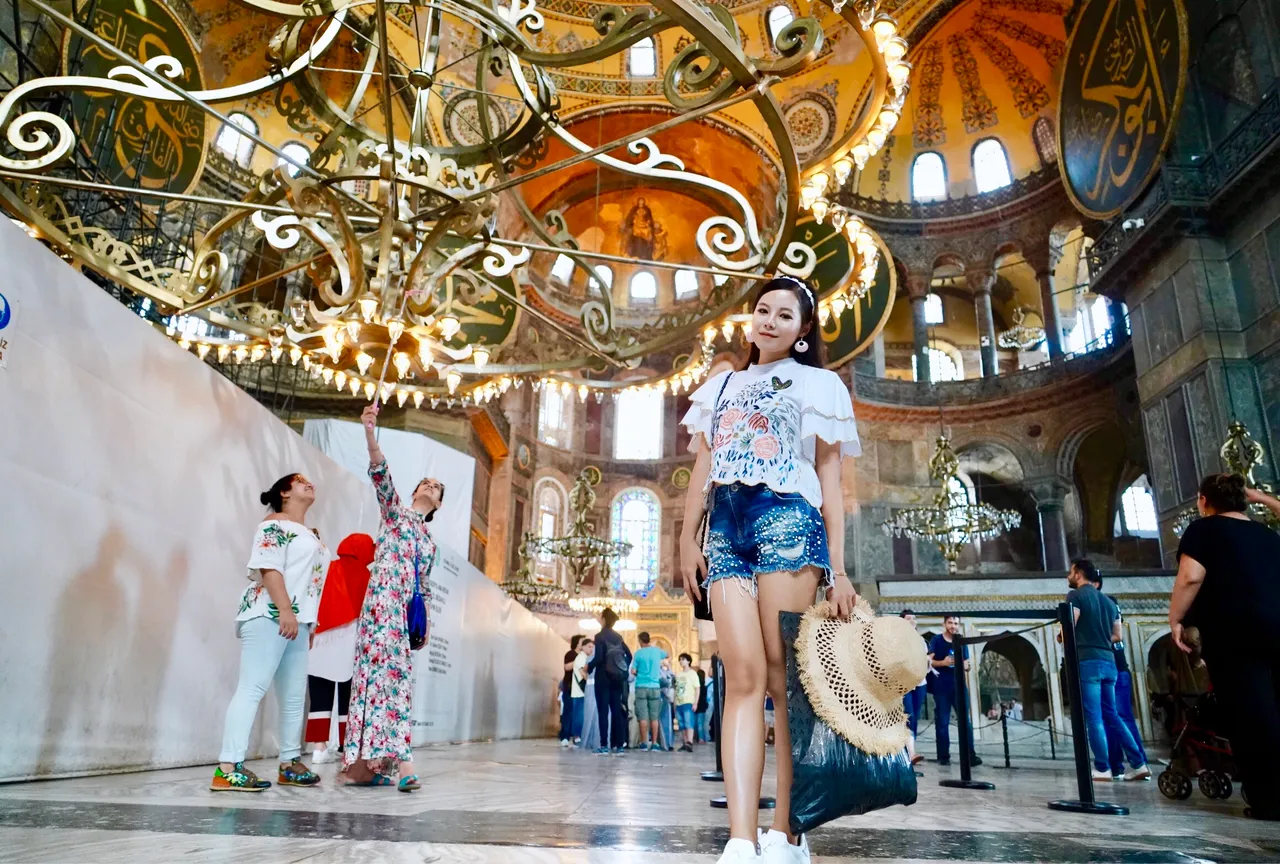
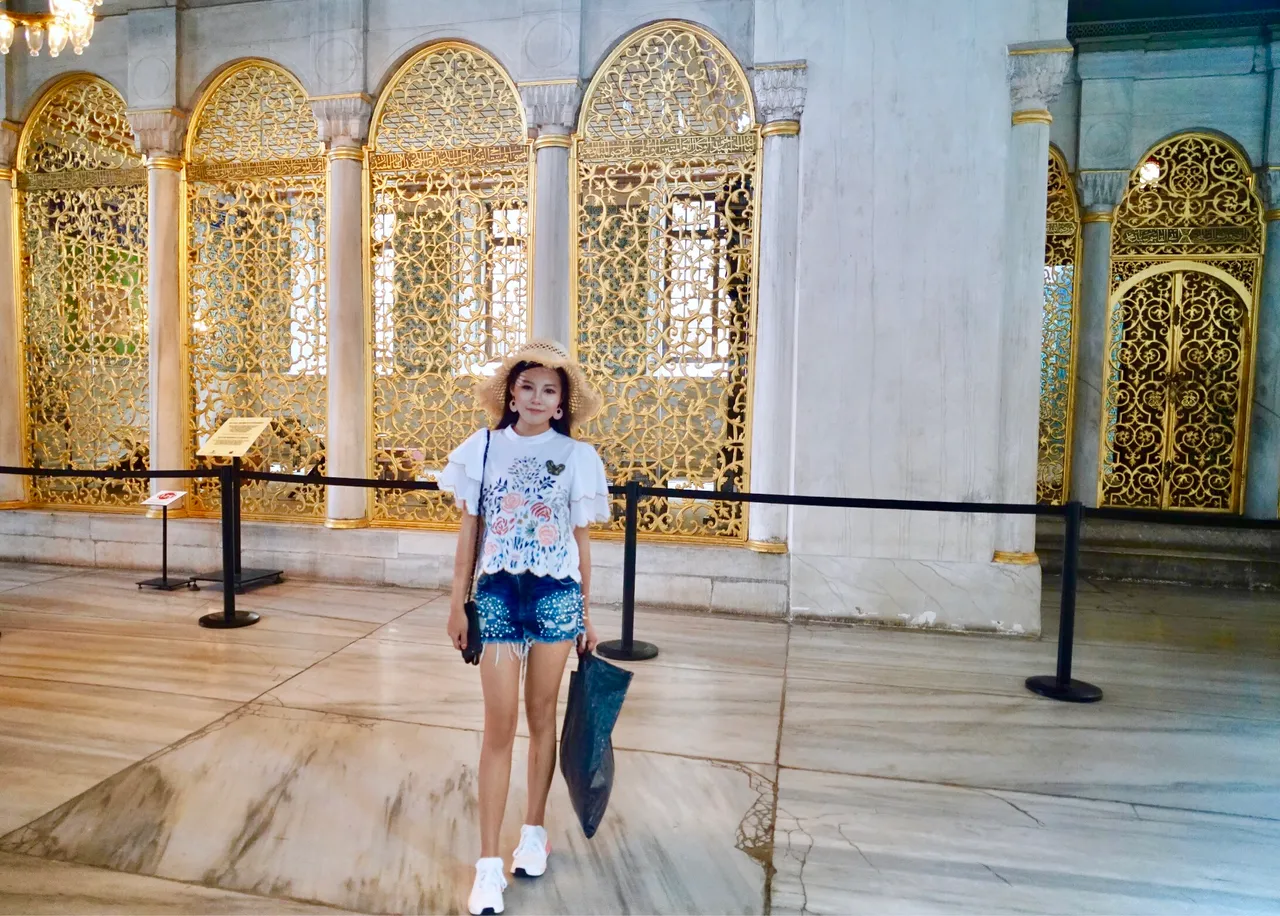
Holding up many areas of the ceiling were columns, but not just boring stone columns. Even these were ornately decorated, and as you can see behind me here, plenty of gold still featured here too. I loved the contrast between the white stone columns and the gold coloured metal dividers separating this private area of the cathedral/mosque/museum off.
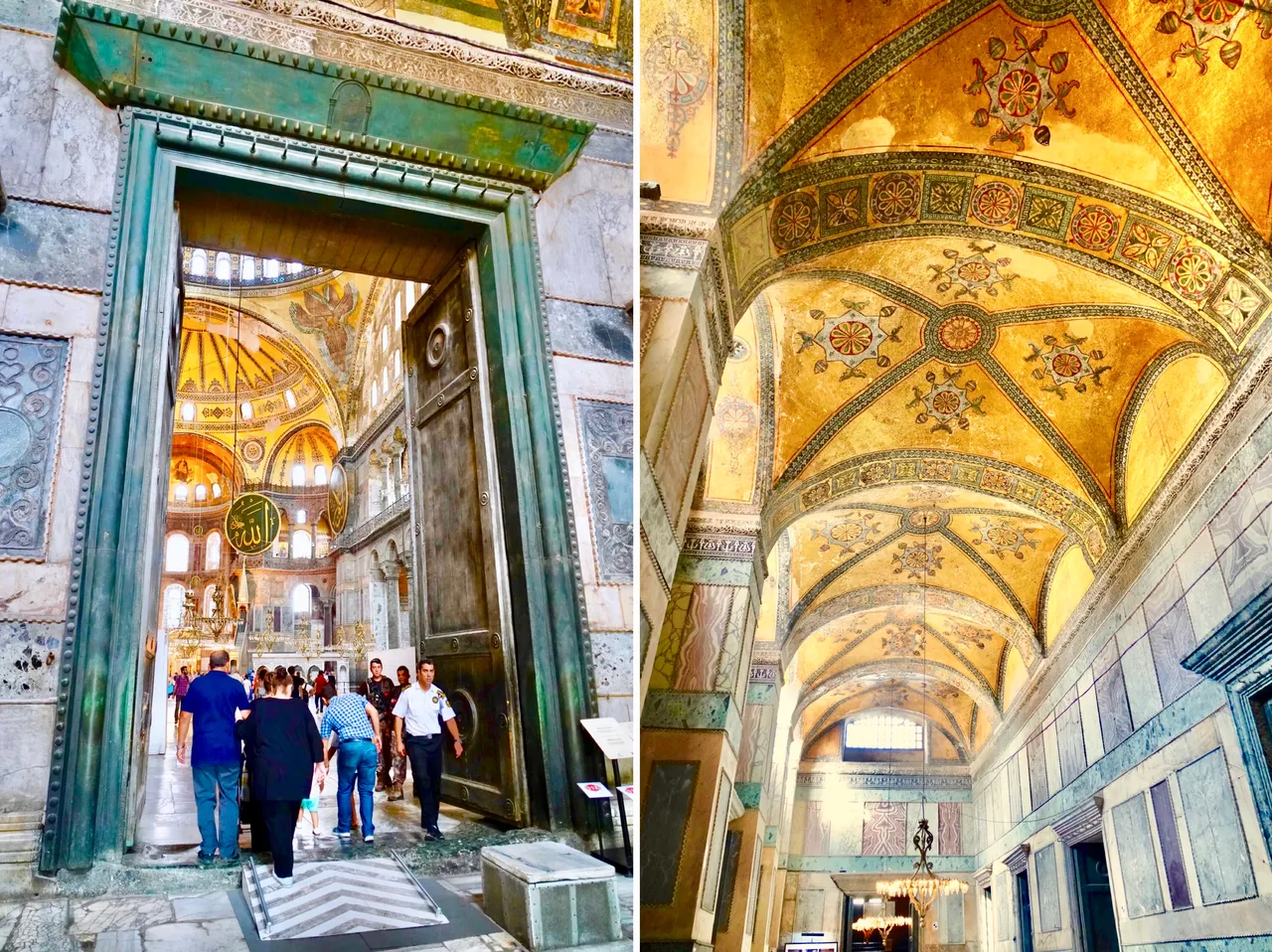
Even the doors are massive, as you can see here! In ancient times, the cathedral served as a place of safety for those fleeing persecution. By law, the religious status of the building allowed it to be safe from attackers and anyone seeking to do harm on people. Many people harboured themselves safely here over the years, and perhaps these really big doors helped keep them safe too!
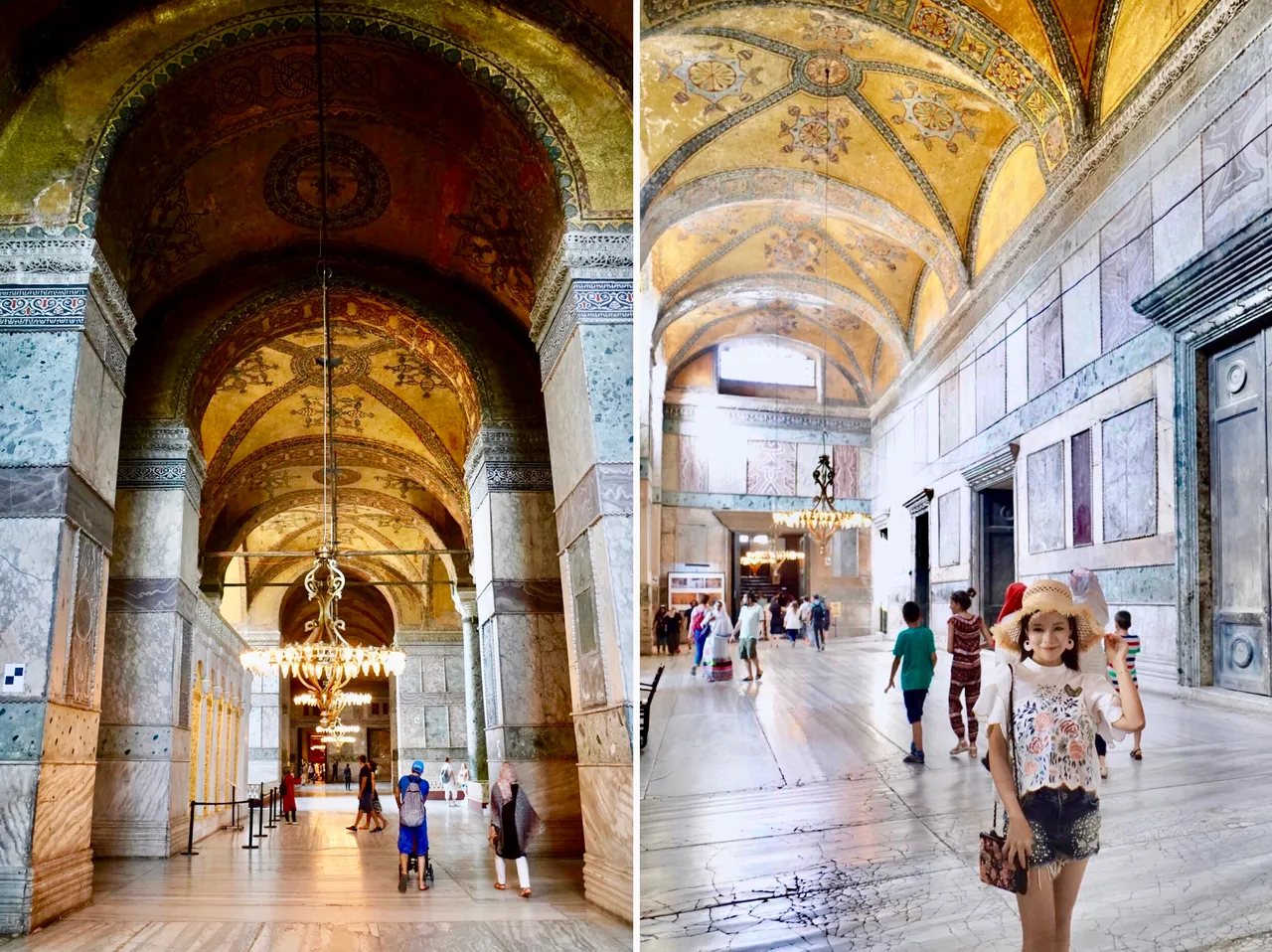
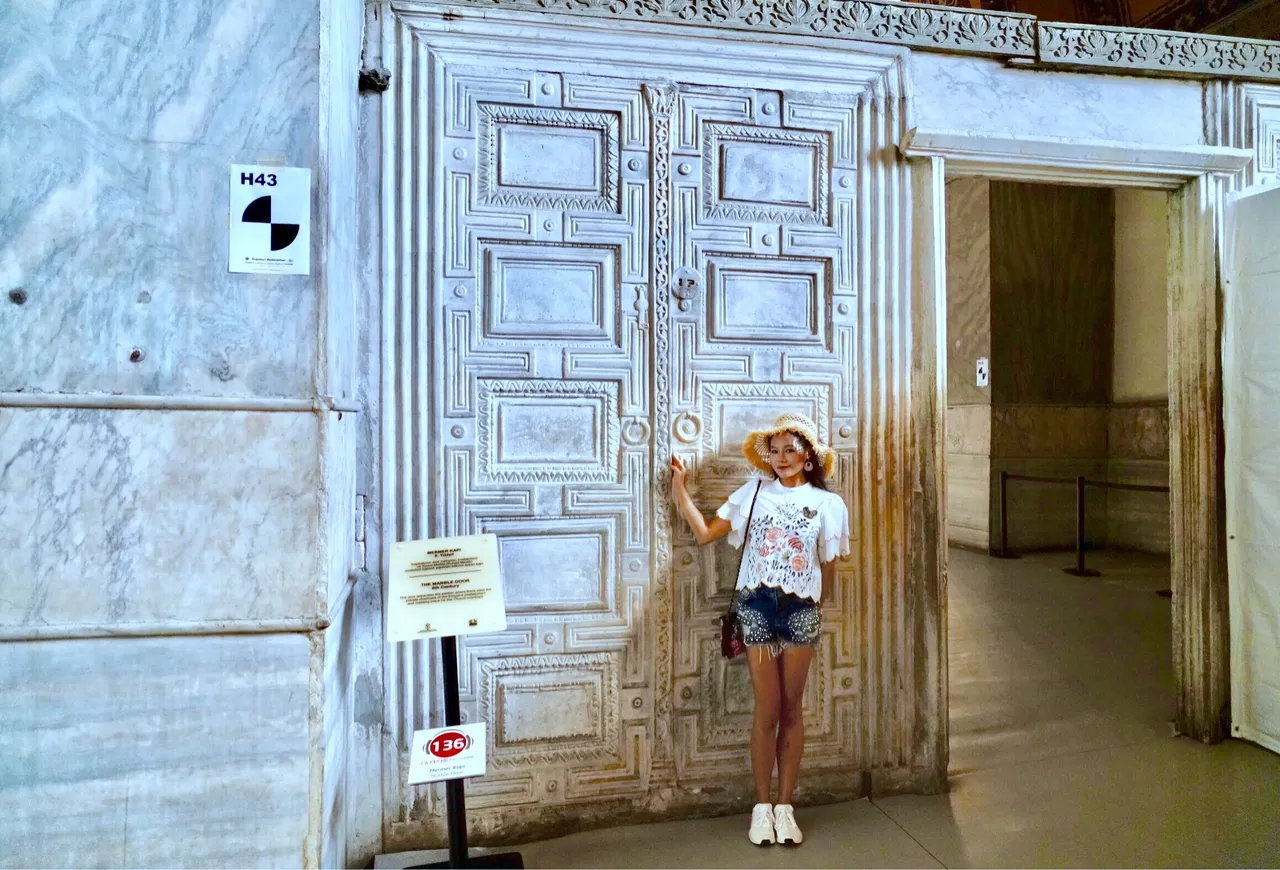
This doorway was fascinating. At one time, it looked like it had actually been a door, but the door had been replaced with a stone carving. Next to the large door stood a smaller door, which still had an opening. I wondered at what point in history the door had been removed, and replaced by a carving? Why close the door up, and if you needed to, why not just put a wall instead of a fake door? The carving was so good that from a distance it just looked like a normal door.
Has anyone else ever come across doors that were carved but not real doors? Do you know why this might have been done? Let me know in the comments below!
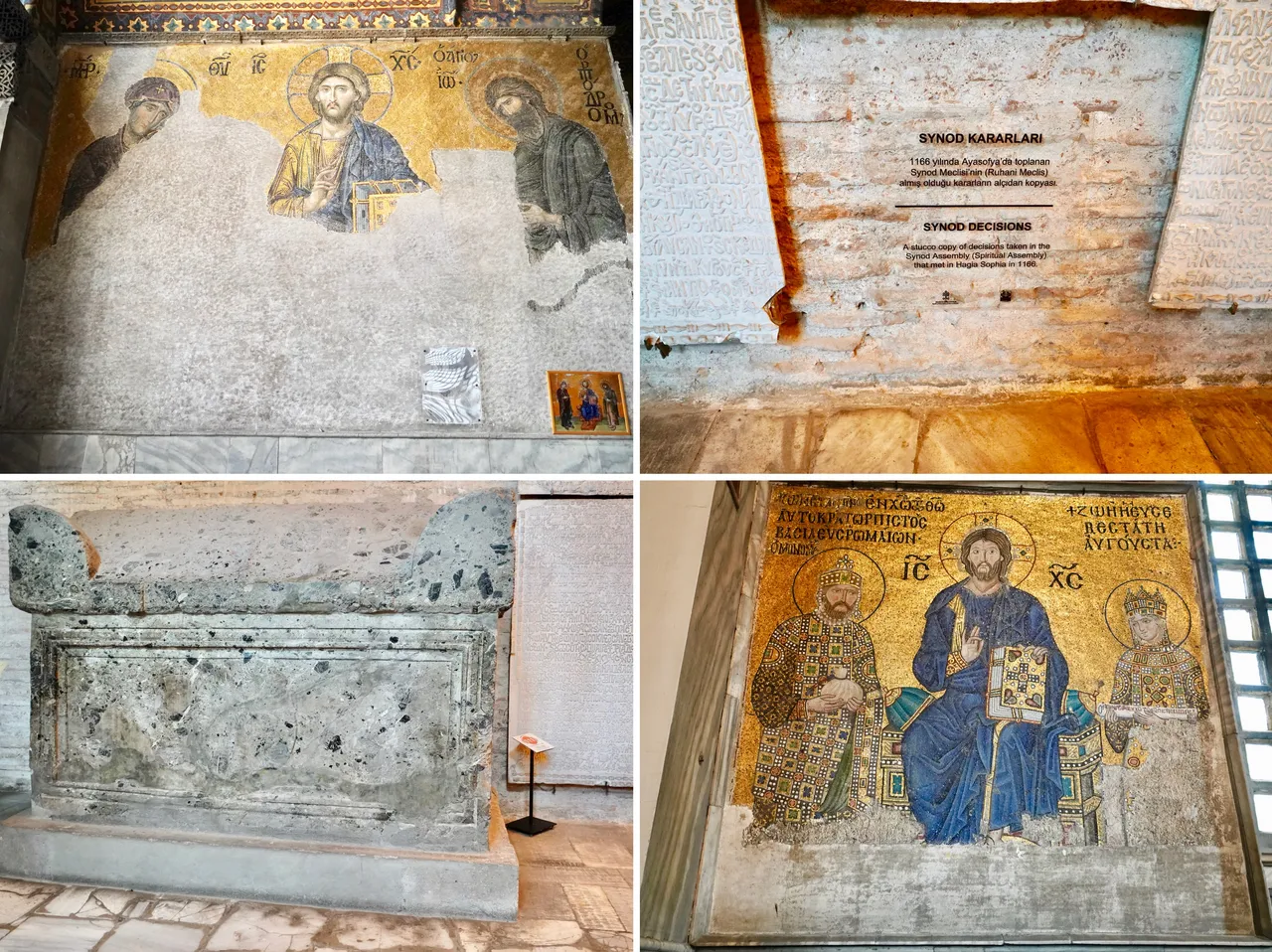
Some of the most famous art works within the museum were the mosaics. These mosaics were incredibly intricate and are some of the greatest surviving examples of such art work in the world. Most of these exhibits were found in the upper gallery of the building and as can be seen from the photos, many of them are incomplete. This is because over time there has been many different natural events as well as simple time, that has caused damage to these beautiful works. The museum, however, now takes great pains to preserve the historic works.
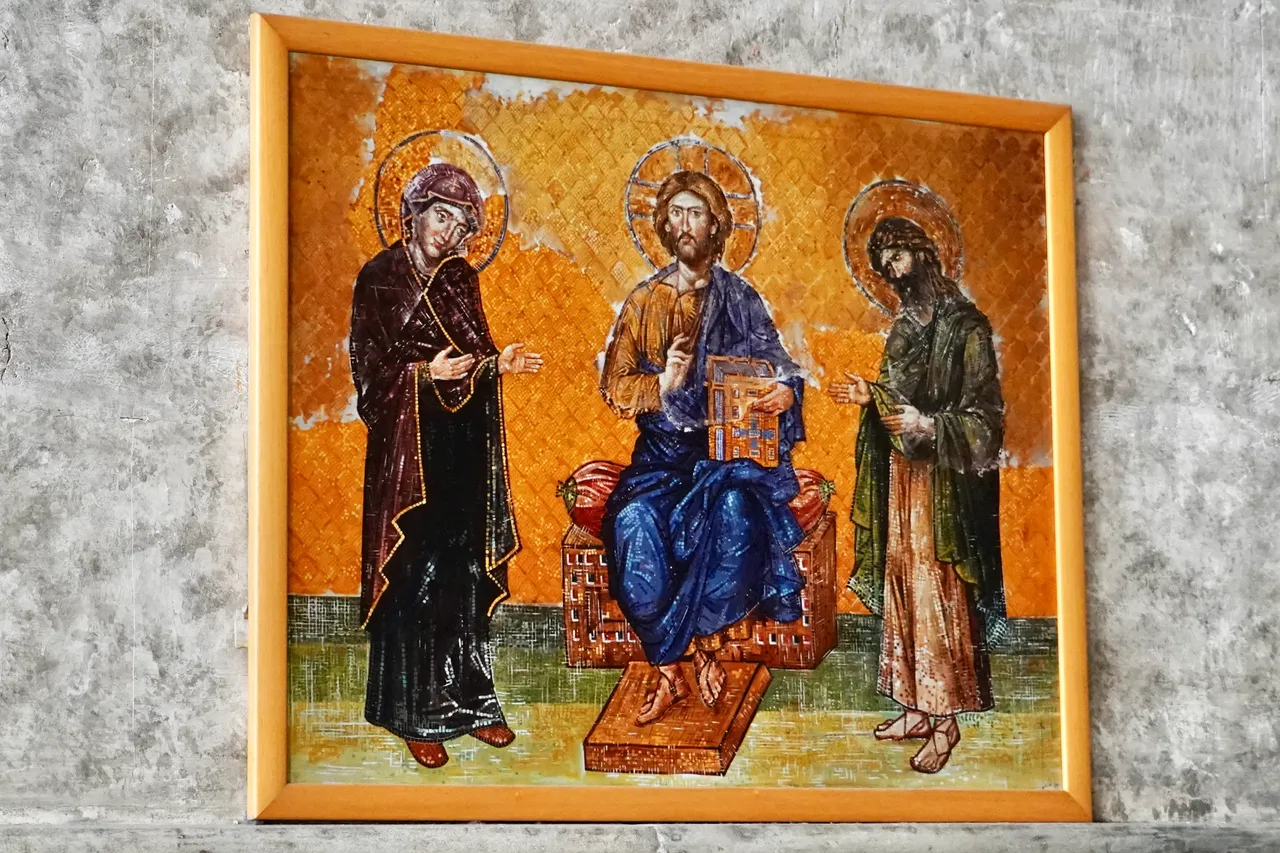
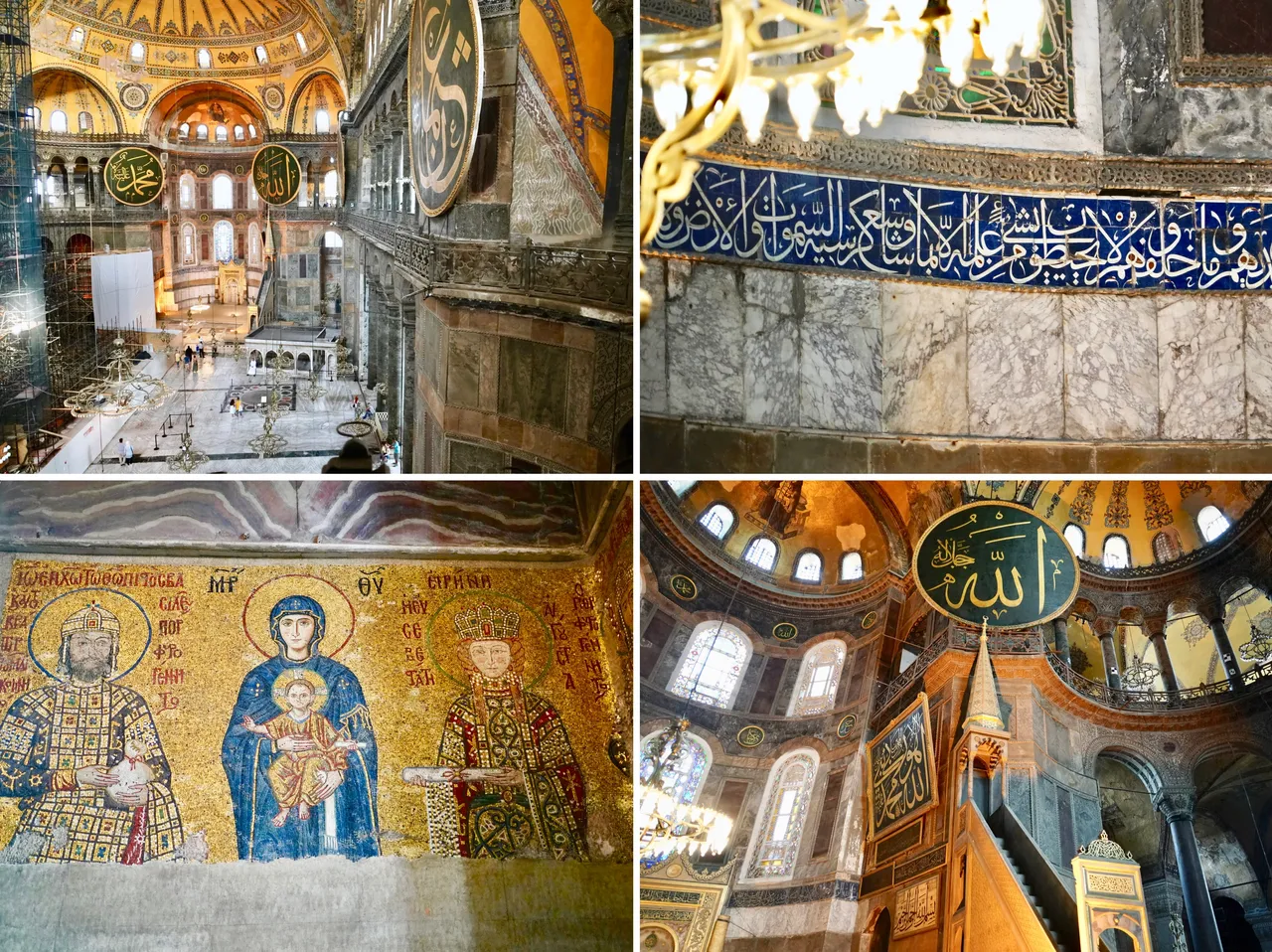

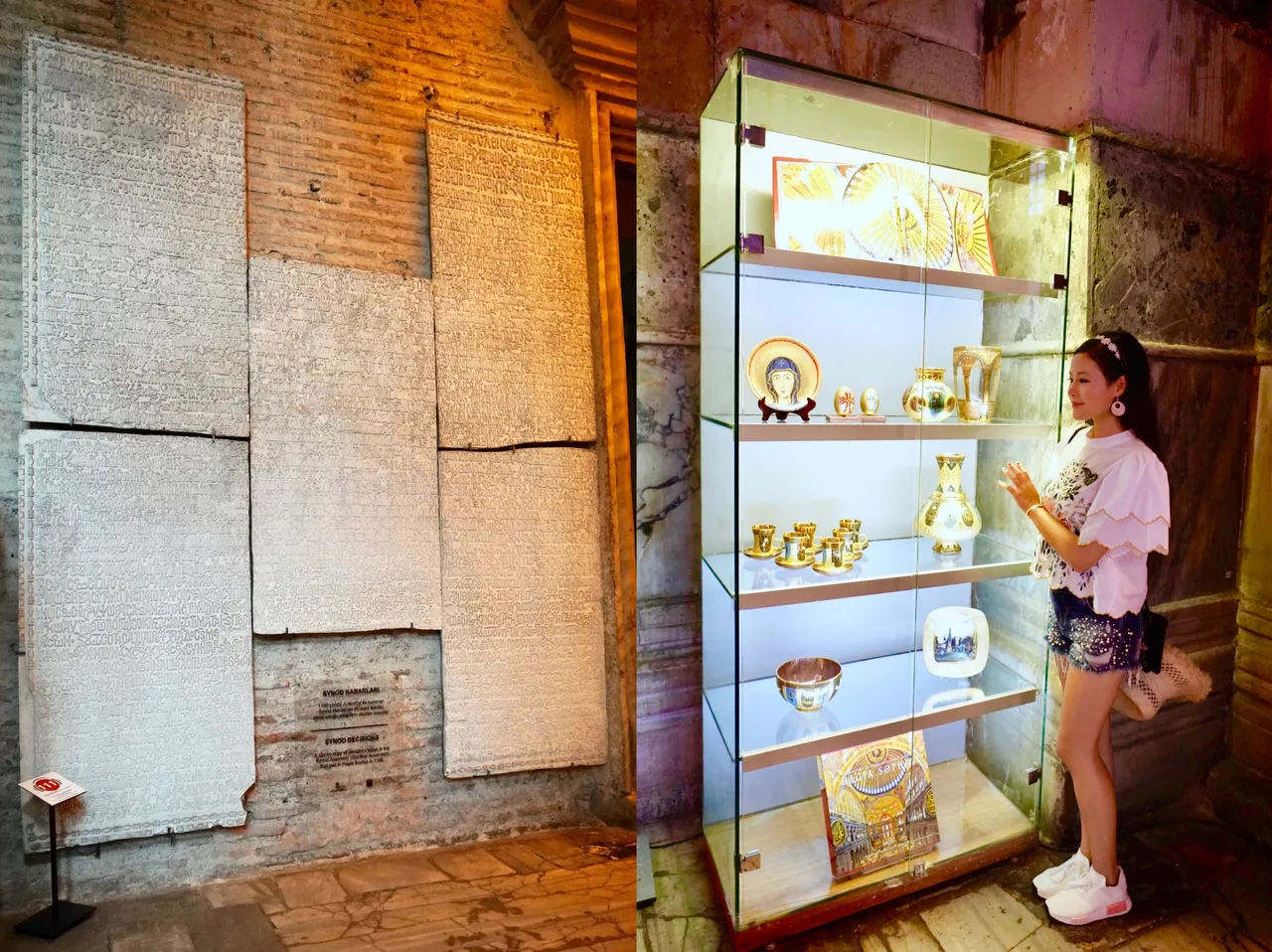
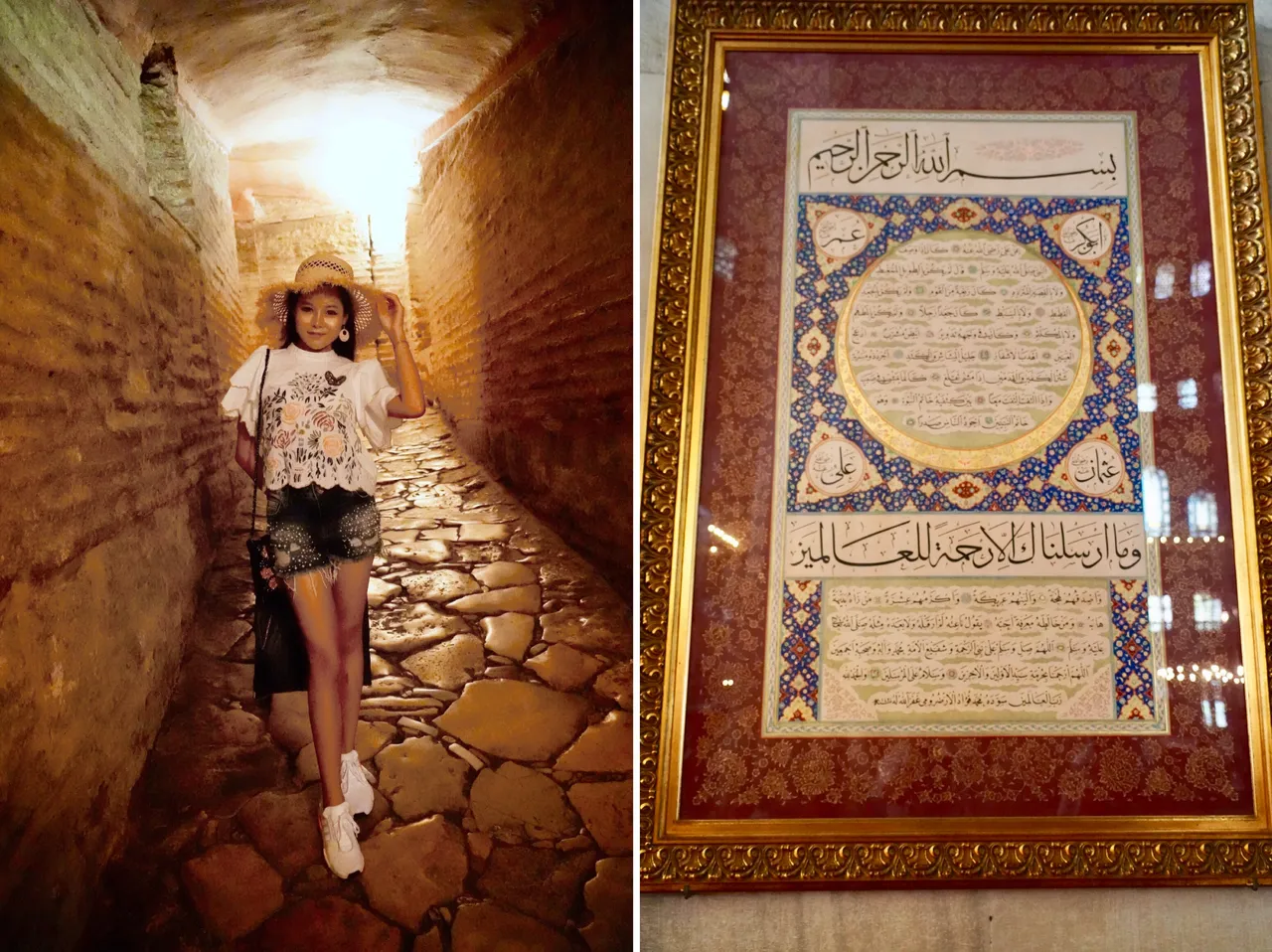
You could spend literally hours searching through the halls, galleries and central chambers of Hagia Sophia. There is art, architecture and beauty, every place you look. The range of different eras that are represented here reflect the long long history of the place. According to experts, there are still areas below the church that have not been fully explored. They are submerged under water and are currently inaccessible. In the adjacent buildings there are buried the remains of five different Sultans of the Ottoman empire, so imagine what secrets could be buried in the tunnels below the museum. I'd love to find out!
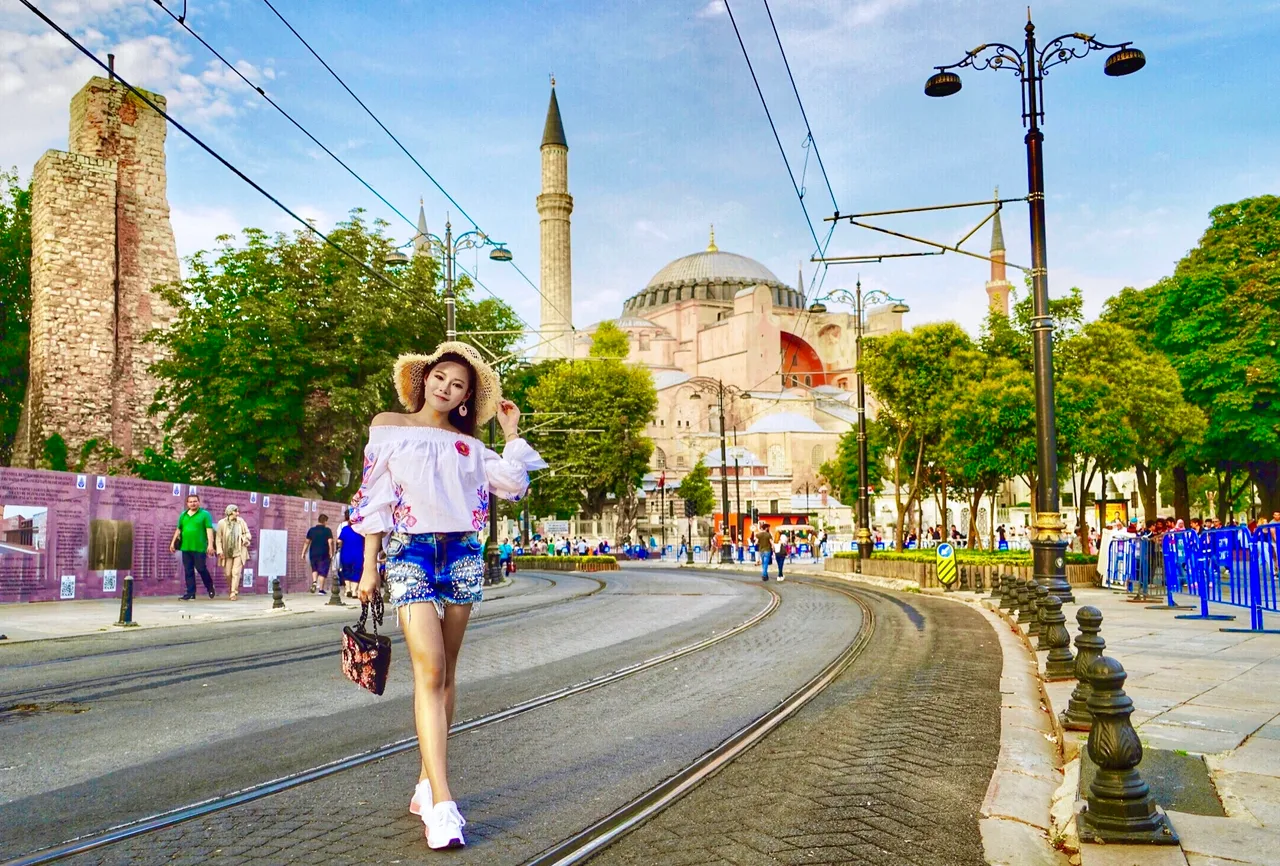
Getting a crazy Uber around Turkey's largest city
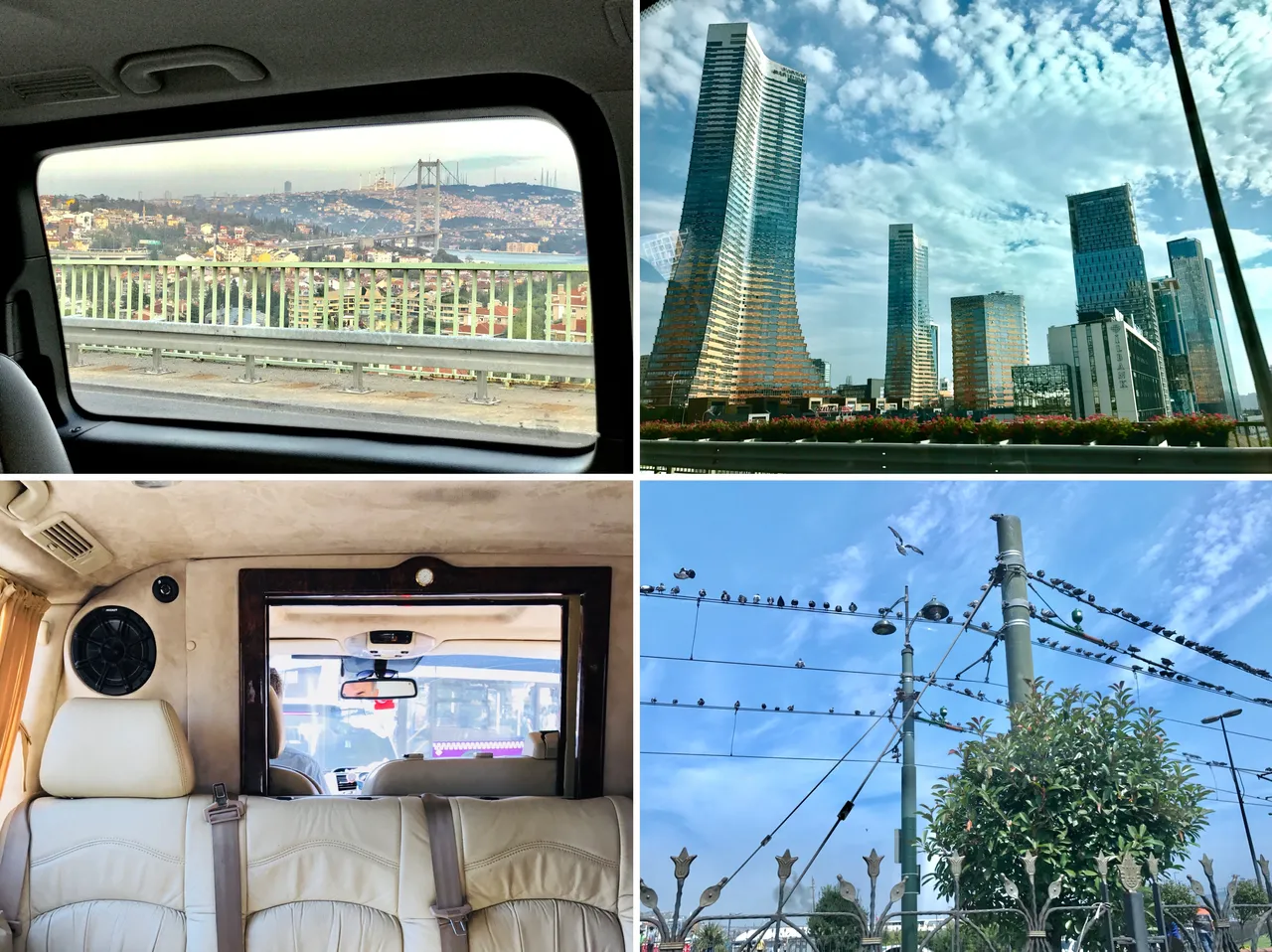
After hours exploring Hagia Sophia it was time to reward myself with a big dinner! I decided to head back to Istinye Park, a huge shopping centre in Istanbul that I have taken you to see with me before. Last time we had some amazing French food in a funky bright cafe, but this time I thought I'd try something a little more casual. It was quite a way away so I decided to call myself an Uber to take me there, and you'll never guess what turned up...

Cruising through the massive city of Istanbul, a city of over 15 million people, I had some amazing views of the city. But I also had some amazing views inside too! Just look at these cream leather seats! This was the most crazy Uber that I had ever been it. I couldn't believe that this was basically a 'taxi'! However, I discovered later in my trip that this wasn't a one off lucky chance. Over the course of my stay in Istanbul I used many different Ubers and found that this style of Uber was almost the normal type! Just look at some of these other crazy cabs that I took.
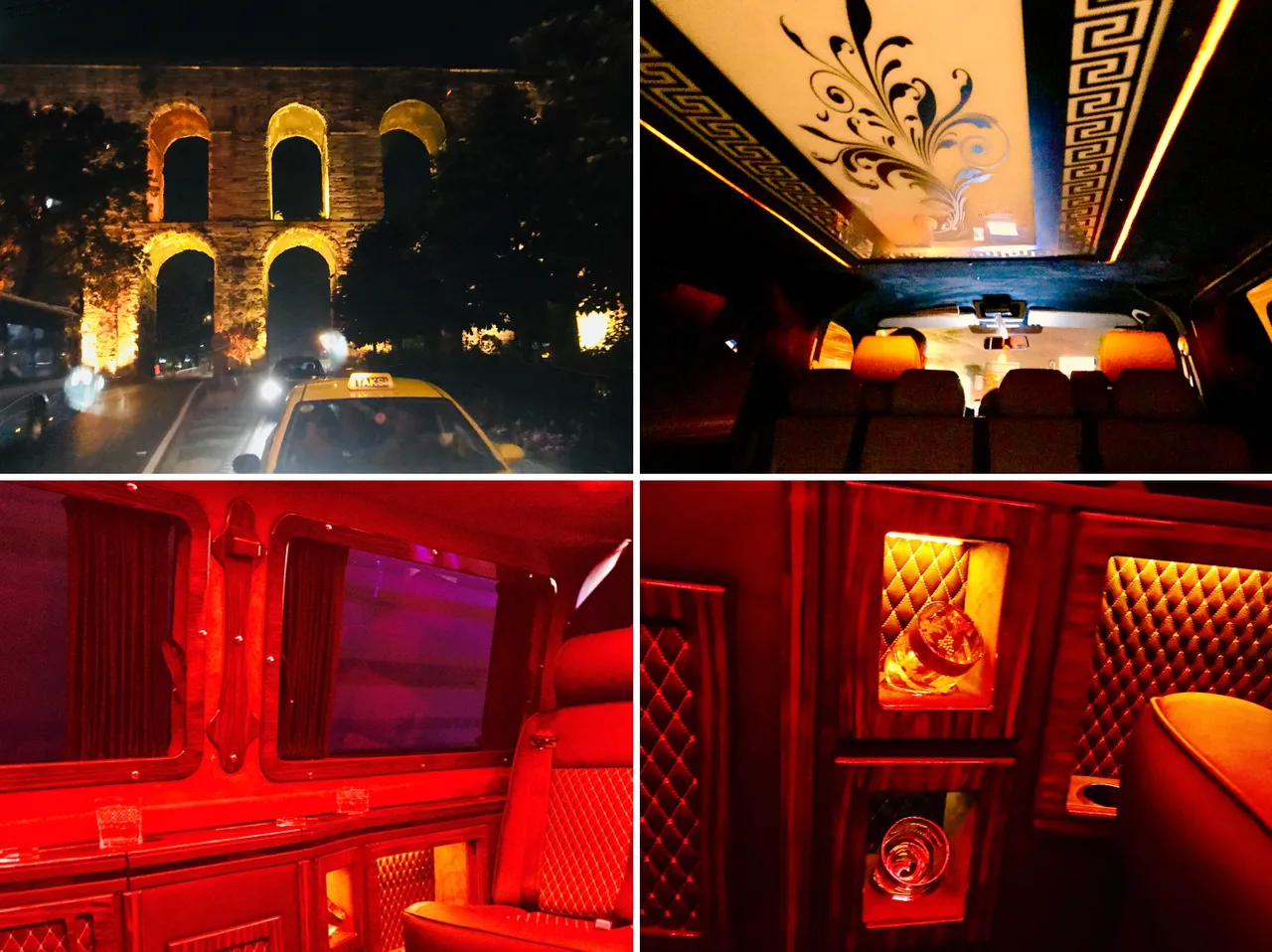
This one had a giant light on the ceiling, like an ornate painting, as if we were in a Las Vegas casino, complete with red lighting all around!

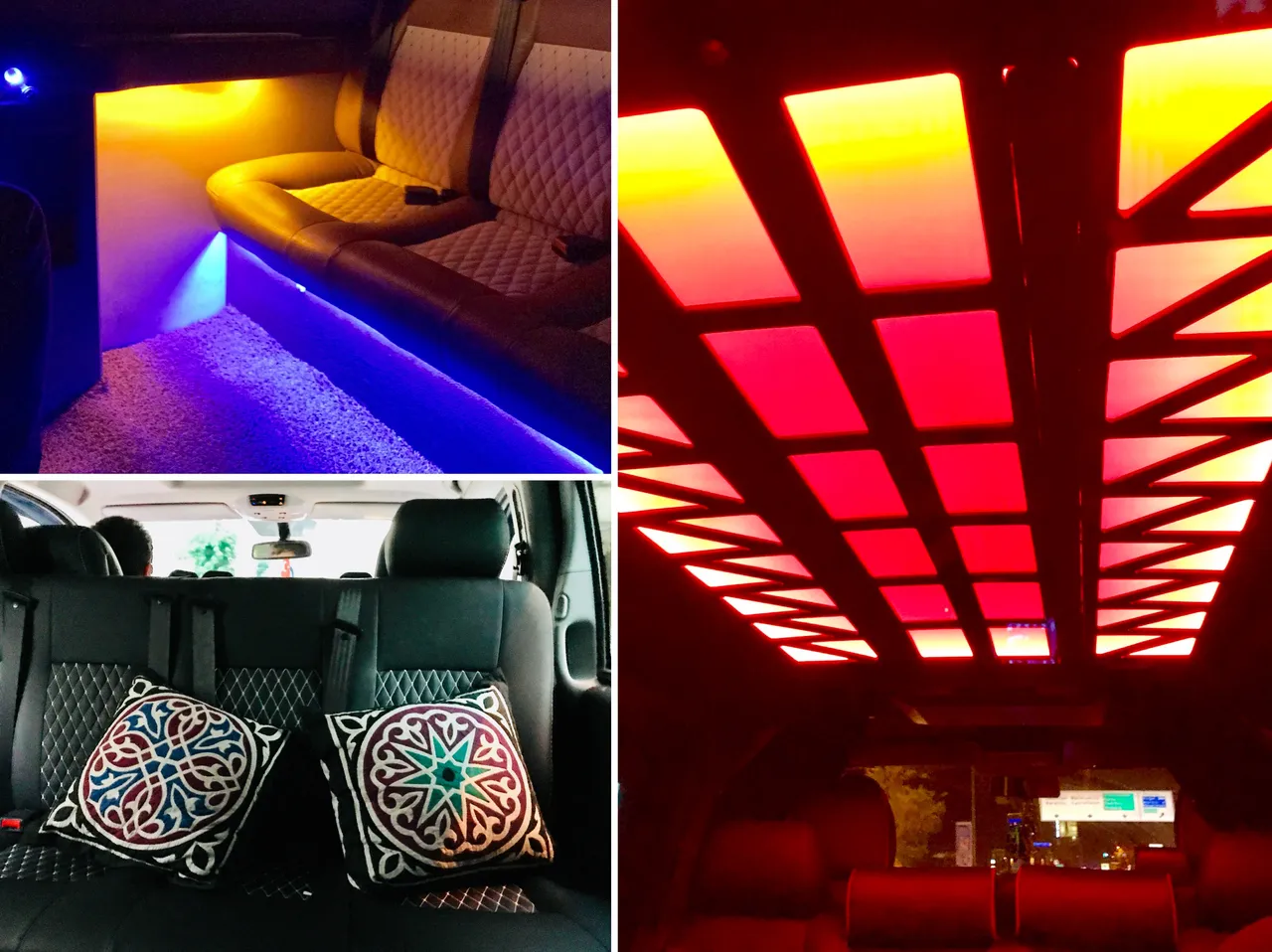
Getting some casual food after a long day in Istinye Park
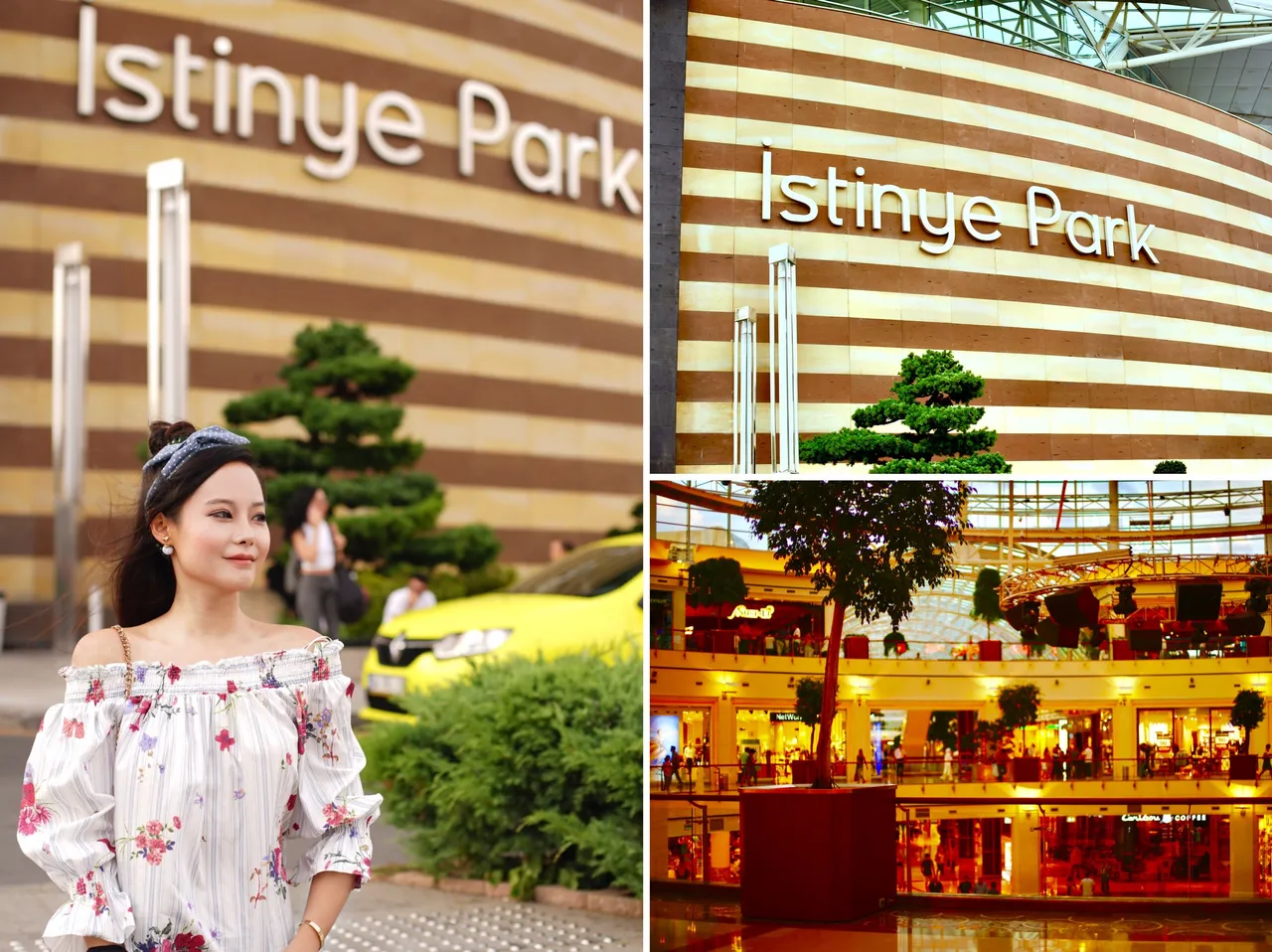
Istinye Park is what I would consider a mega shopping centre. It has over 300 stores, four levels of underground parking just for the shopping centre, and 85,000m² of retail area. It even has an open air area complete with park and dozens of restaurants. First opened in 2007, it has become a massive attraction for both tourists and locals alike.
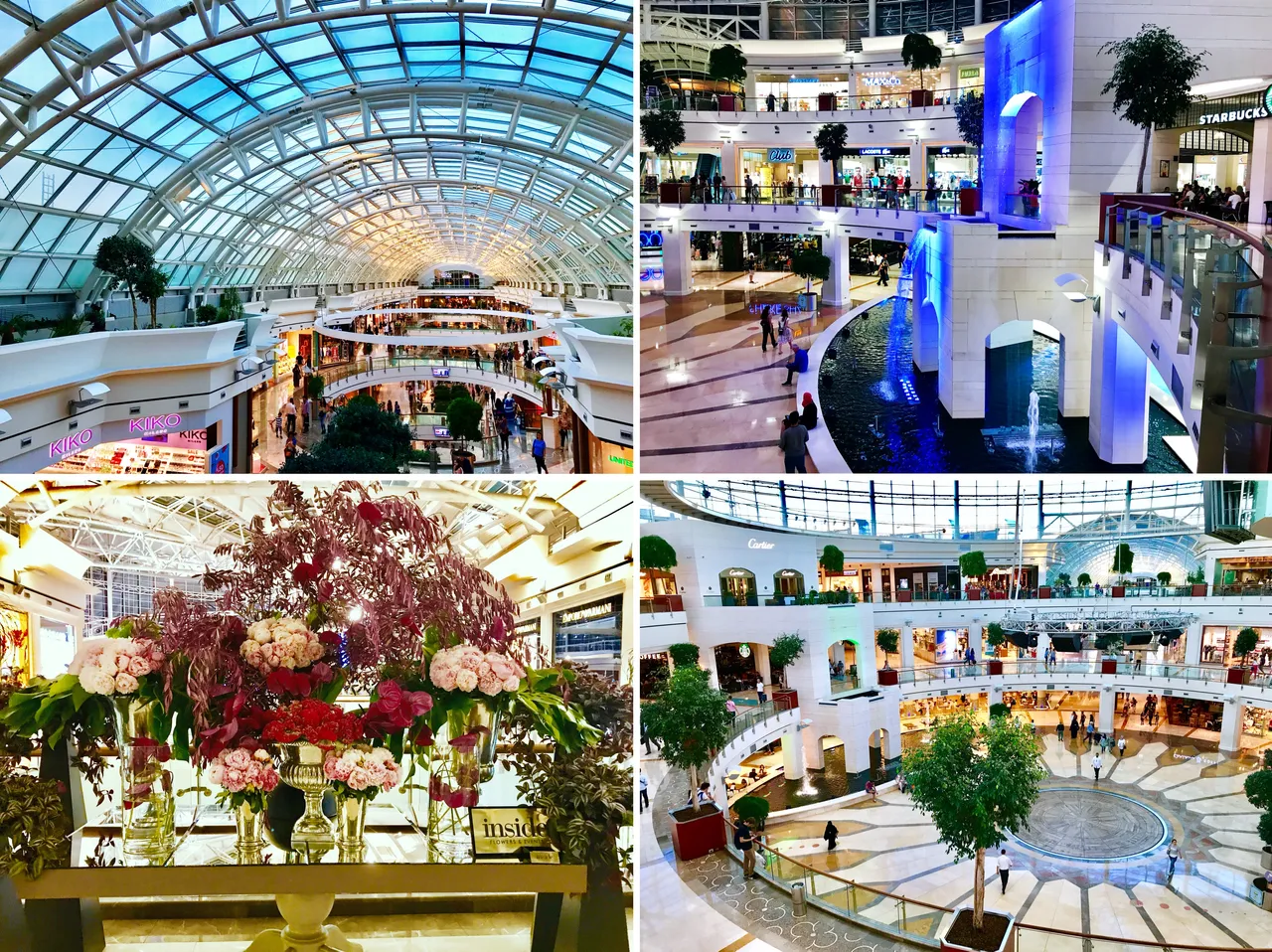
The design of the building is amazing. It's absolutely huge and has everything from trees to a waterfall inside the massive glass arched roofs. Having been here before and having eyed up a few different places to eat, I didn't take long to look around. I needed to get some food in my tummy, because I was hungry!
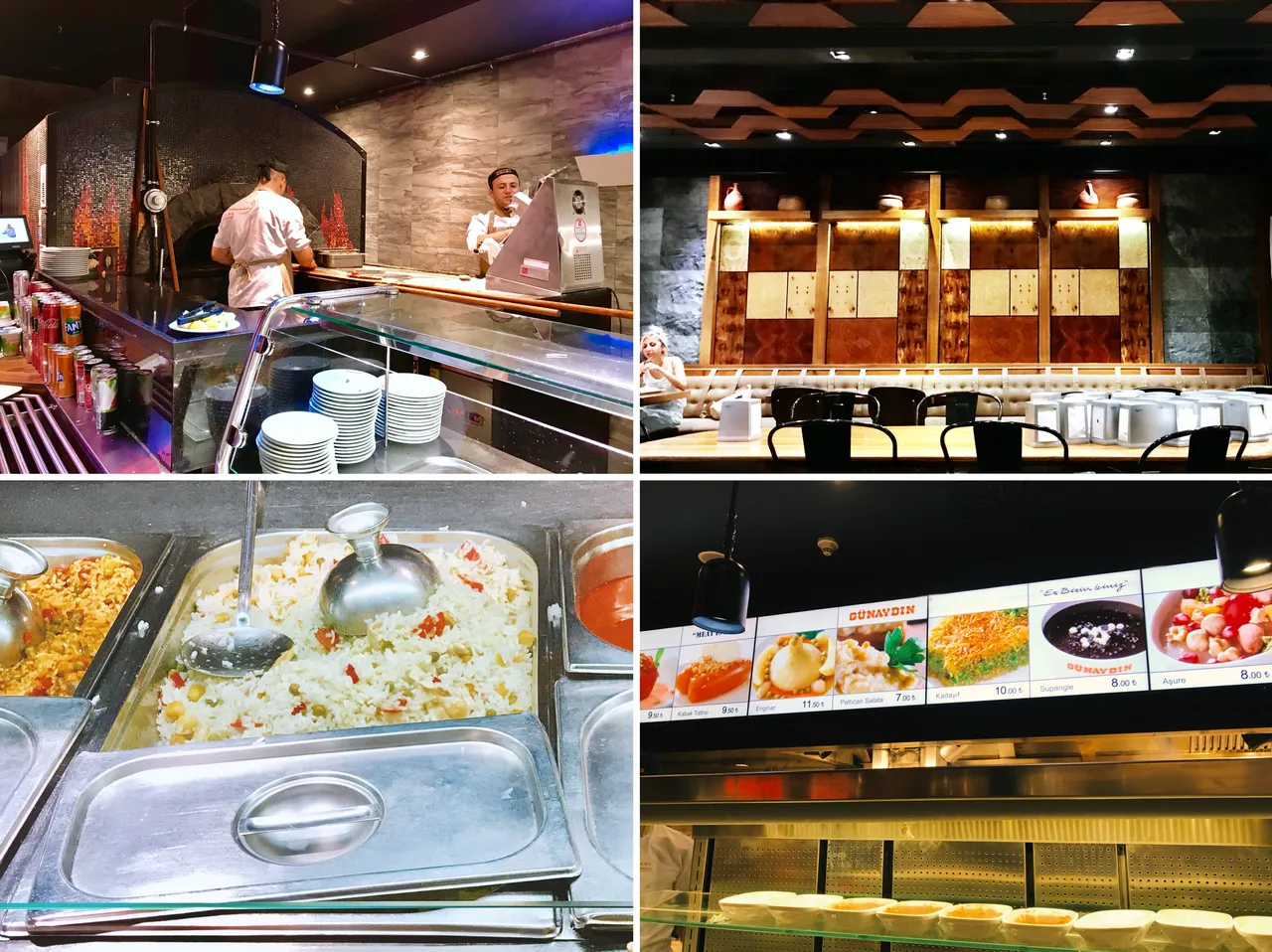
I settled on Gunaydin Steakhouse because it looked like somewhere I could get some food, quick! With a range of different foods, and plenty of meat on the menu, it wasn't hard to pick a bunch of different dishes to satisfy my taste buds.
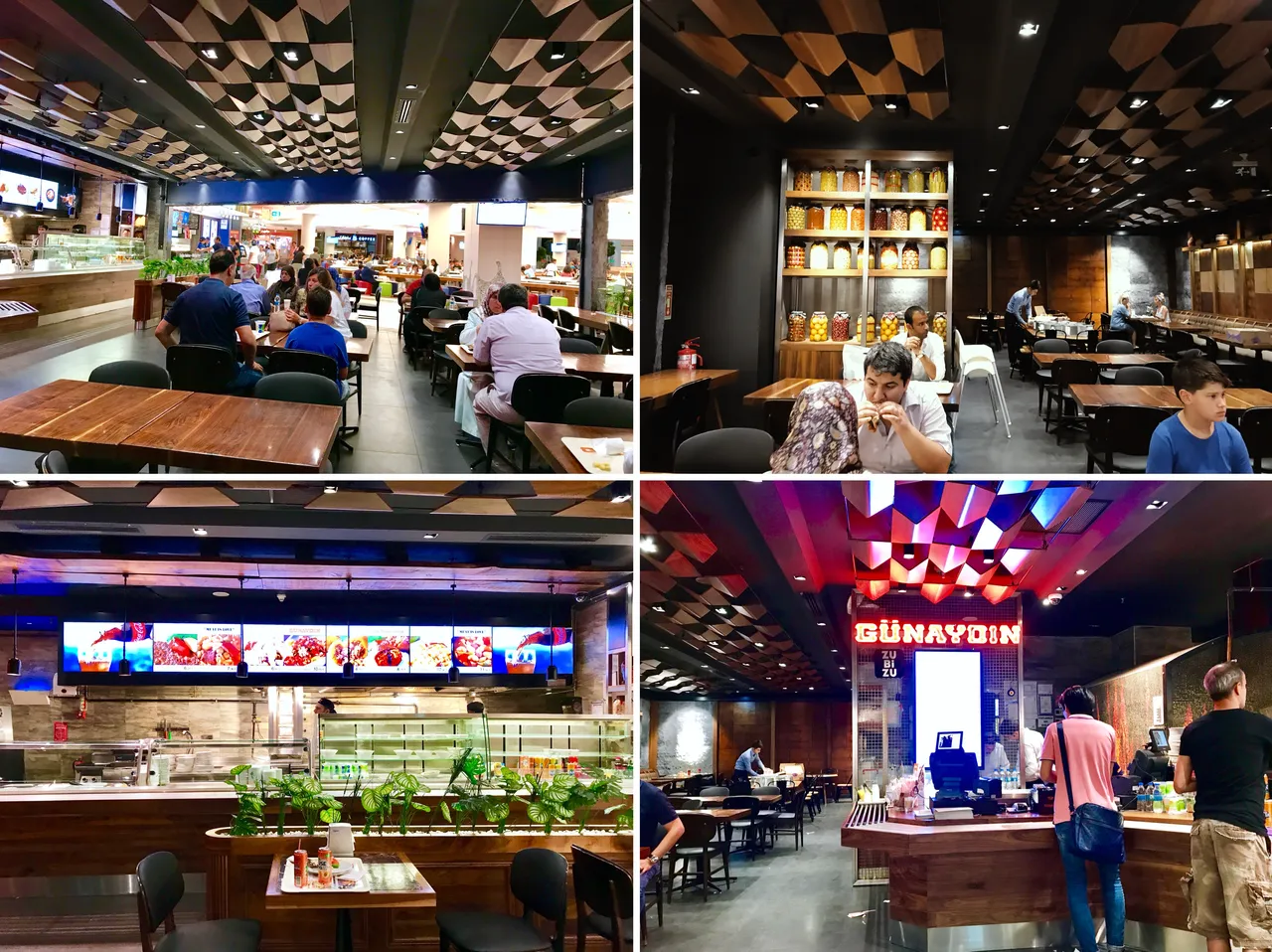
Half restaurant, half fast food canteen, it still had a great vibe. I felt like of like I was in a food court, that you get in these big shopping centres, but Gunaydin Steakhouse had its own little section off to the side with its own tables and decorations. You still ordered your food up at the counter and took it to your table, though, as you would in a food court.
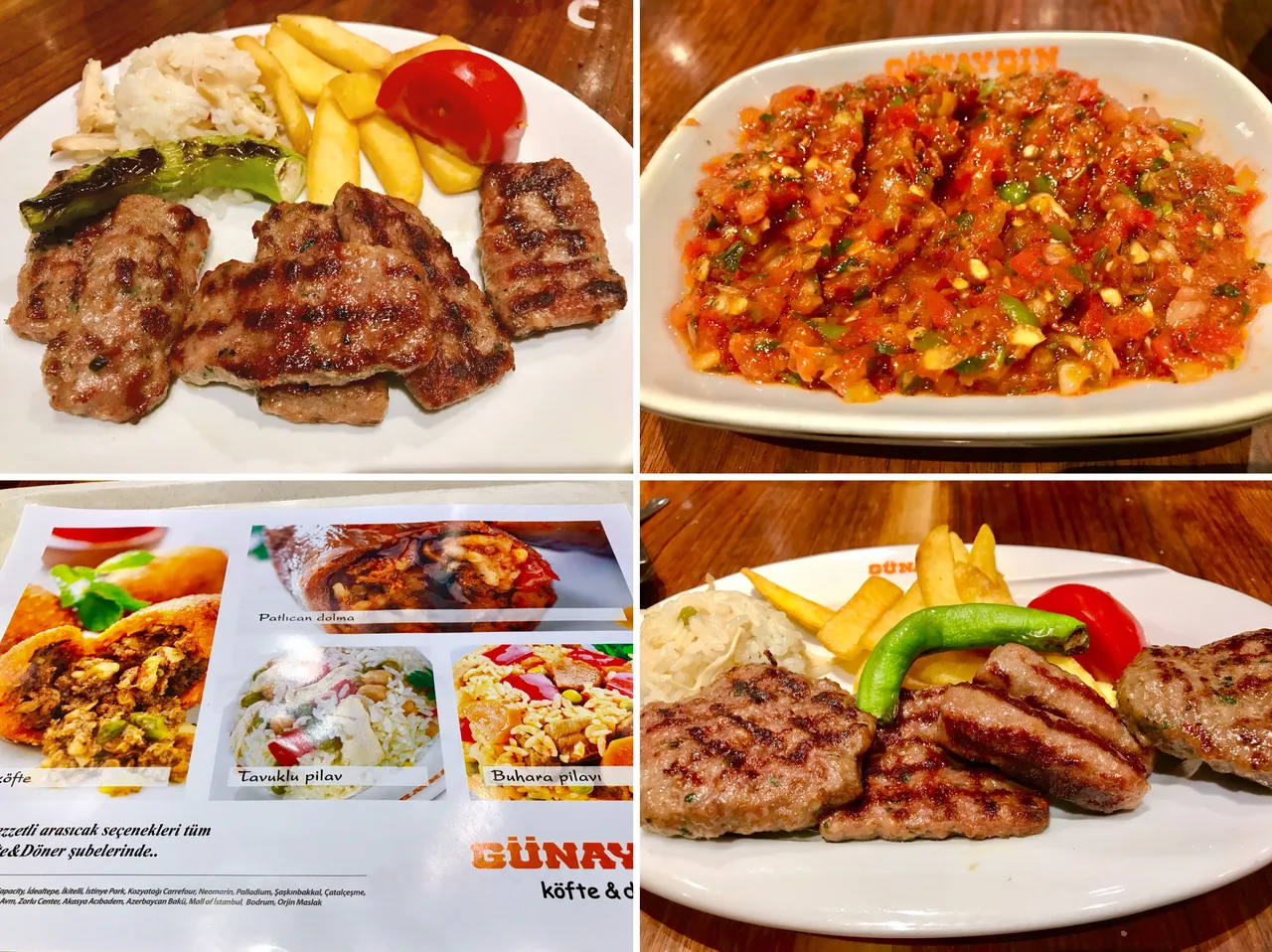

Since it was a steak house I definitely had to order some meat. So I got some beef as well as some beautiful side dishes and soup. I loved the side salads with the big serving of meat, so I felt quite virtuous (as well as really full). The desserts were a little bit... pre-made. They tasted OK but you could tell they had perhaps been made the day before or had been sitting there for a long time. With that said, they were still pretty good after a long day of sight seeing!

As you can tell... I was pretty hungry! That's the smile of a full tummy

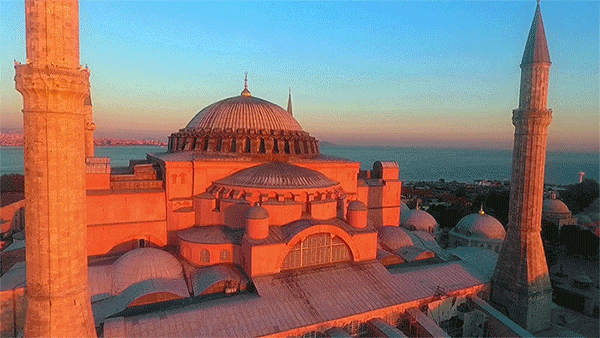
I hope so much that you enjoyed this epic post about the amazing Hagia Sophia. I told you you would see shots of this historic building, like you'd never seen before. And here they are. On my way back home after dinner, I saw the sun setting and since I was passing close to the historic landmark, I wanted to go and see it in the orange sunlight.
The view was even better than in the day. The rays of sun bouncing off the red stone brick made it look even more massive and beautiful. I had to get the drone out to see it in all its glory. There are few places that you will ever see shots like these of the ancient Byzantine cathedral. You, Steemit friends, are very lucky, as was I when I managed to get the shots with such perfect light and timing.
I can't believe I have come to the end of another post. Reliving my time at this stunning building has been really special and I hope you can appreciate and see the splendour of this building. I asked a few questions in the post - if you know the answer to them, comment down below! If you enjoyed the article or some particular photos, I'd also love to hear from you. Also, if you like content like this, and you want to keep supporting Steemit, then please do give me a follow so you don't miss any future posts and stay part of my community with me! I love all of my followers and love hearing from you all.
Have a great day, all of you, and I'll leave you with these final shots of this beautiful place that I am so humbled to have visited.
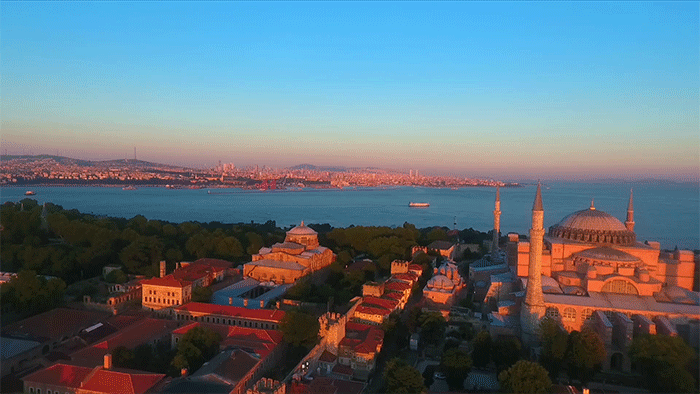
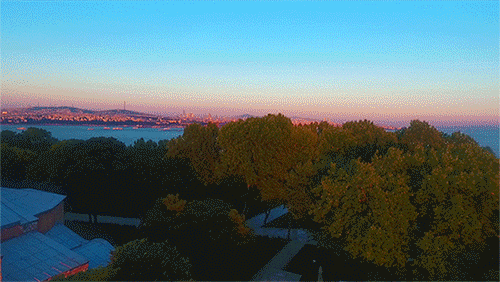
Check out my video with some aerial footage!
亲爱的朋友们,好久不见啦,今天我迫不及待地想和大家继续分享我在伊斯坦布尔另一段奇妙的旅程,大家准备好了没。现在就跟上我的脚步,一起去往童话般的伊斯坦布尔地标建筑——圣索菲亚大教堂吧。伊斯坦布尔自古就担当着“文化大熔炉”的角色,它吸收多元文化的能力甚至可以与纽约相媲美,而圣索菲亚大教堂绝对是最能体现文化大融合的地标。站在伊斯坦布尔老城区酒店的天台,登高望远,左手圣索菲亚大教堂,右手蓝色清真寺,在这里可以深深体验到伊斯坦布尔这座城市的文化包容性,因为你会奇妙的发现圣索菲亚大教堂和蓝色清真寺仅仅隔了一条马路,但这两种截然不同的文化信仰却从未有过宗教冲突,也可以平和安逸的融入在伊斯坦布尔老城区的美景之中。在上一篇里,我们一起去领略了神圣的蓝色清真寺,现在我们就一起去探索一下它的邻居,这座绝美的东罗马时代建筑杰作,世界上唯一的“混血教堂”。
历尽劫难的“混血大教堂”
拥有1500年悠久历史的圣索菲亚大教堂,同样拥有着像蓝色清真寺一样丰厚的文化历史渊源。“索菲亚”源自希腊语里圣神智慧的意思,这座上帝圣智教堂正是供奉了正教神学里的耶稣。关于这座教堂的建成,也辗转出了不少故事。在这座教堂伫立的地点上,其实曾经存在过两座被暴乱摧毁的教堂,还好拜占庭皇帝查士丁尼一世下令建造的第三座教堂永远的留存了下来,可以说是一波三折呀,这座教堂就是如今竖立在我们面前的圣索菲亚大教堂,这座大教堂直到1519年被塞维利亚主教堂取代之前,一直都是世界上最大的教堂。在临近大教堂的路上,有一条悠长的轨道,不时看见有轨电车缓缓的经过大教堂,仿佛把我带入了童话世界,沉浸在浪漫复古的情调里。纵观这座迷人建筑的历史,可以说它在数百年起起伏伏中经历着坎坷的命运,其间饱受了大地震的毁灭性侵害,见证了帝国加冕仪式的辉煌盛况,遭受摧毁圣像运动和大火的破坏,甚至在十字军东征期间被拉丁基督徒洗劫和亵渎。
在1453年穆罕默德一世占领君士坦丁堡(并改名为伊斯坦布尔)之后,便给基督教堂圣索菲亚加了四个宣礼塔,从此这座建筑的神秘身份便由教堂正式转换为阿亚索菲亚清真寺。这也是世界上唯一由神庙改建为教堂、并由教堂改造的清真寺,一座拥有奇幻“人生”的建筑。更意想不到的是,这座建筑被沿用至今的身份其实是博物馆,1935年,第一任土耳其总统及土耳其国父将圣索菲亚大教堂变成博物馆,1985年,圣索菲亚大教堂所在的伊斯坦布尔文化老城区被联合国教科文组织选为世界文化遗产。1996年至1998年,博物馆还被世界文化遗产基金会选为百大濒危遗产。你可能会好奇,历经了数不尽的劫难,如今的教堂是如何以如此完美的形象展示在世人面前的。我想大概要感谢每一段时期,教堂的主人都未曾放弃过对于建筑的修复工作。随着伊斯坦布尔当选为2010年的欧洲文化之都,对大教堂的修复工作也被重新提上议程。这一次来参观的时候,我就正好赶上教堂修复,见到了重达160吨的脚手架矗立于教堂中央的场景。
走进教堂
纵观这座粉色的教堂,它巨大的圆顶非常吸引眼球,当年的建筑师们采用了希腊的理论,在硕大的空间之上构造了巨大的圆顶。据说这座大教堂也是因为这个圆顶而闻名于世,它的突出成就在于创造了以帆拱上的穹顶为中心的复杂拱券结构平衡体系,因此这座教堂也成为了改变建筑史的拜占庭建筑典范。作为在这片土地建造的第三个教堂,它从风格上就与前两个迥然不同,视觉上也愈发的雄伟壮观。圆顶形状一直是伊斯兰建筑的代名词,是最常见且最标志性的清真寺结构形状。从地面和空中凝视这个独特的教堂圆顶,你都会发现它似乎不同于我们经常在伊斯兰建筑中见到的圆顶形状,这个不寻常的圆顶让这座建筑变得独一无二。
走进教堂,令我惊讶的是这座教堂比蓝色清真寺还要大,据说这座教堂每年可以接待250万的外国游客,放眼望去巨大的教堂主殿灯火辉煌。最夺目的就是这一盏盏悬挂于半空的吊灯,排成了花朵的形状,宛如璀璨的星空,为教堂提供了明亮的光线,更增添几分庄严肃穆的神秘之感。这座典雅精致的教堂在建造初期,有超过了1万人参与工作,耗时5年终于取代了曾经在同一个地点的另一座教堂,仔细观察每一处的细节都展现了建筑师伟大的创造力。教堂的墙壁上,依稀可见基督教的壁画,也残留着拜占庭帝国的痕迹。四处都绘有精美的花纹,如果你仔细观察,会看到有些漂亮的伊斯兰花纹后面竟然有浅浅的基督教十字架图案和雕刻,这种两个教派的元素重叠出现的情况造就了这片迷人的探索之地,这样独一无二的特色也使得圣索菲亚大教堂成为世界唯一的混血教堂。
4块直径7.5米的圆形大牌匾十分醒目,上面用阿拉伯文写着穆罕穆德、真主、四位国王的名字以及穆罕穆德两个孙子的名字。圣索菲亚大教堂的长度为82米,宽度为73米。这座大教堂好像是会变戏法的魔幻世界,从外面看最醒目的中央圆顶外形,在内部实际是可以看到多个互连的圆顶,并且每一个的装饰都各不相同,金色镶嵌于宗教图案里并巧妙的融合其中。站在高达55米的中央圆顶之下,我觉得自己格外渺小,这样精妙绝伦的装潢,让我情不自禁抬着脖子静静仰望到酸痛,好后悔没有自带个望远镜可以精细的观看,在教堂中间有一个精美的“苏丹包厢”,据说是为了保证苏丹安全,而给苏丹特别设置的地方,很像是一个机关。
虽然和往常一样,教堂的正中心拉着护栏以保护真迹,游客是不可以穿越护栏走入里面的,但是我却发现,一位看上去像教堂小主人的小猫咪正在护栏里面自由的散步,并走到游客人群正前方,似乎是要开始即兴路演,也好像是一位资深的教堂安保人员,十分抢镜,哈哈,这就是伊斯坦布尔神奇的地方,仿佛这座城市的每一处角落,都能邂逅可爱的小猫咪,整座城市就像是一个硕大的猫咪游乐园。能看得出土耳其人发自内心的喜爱着小猫咪,这一次也给了这只小花猫特权,让它置身于文物古迹当中,教堂的保安人员还热情的递给我猫食,给我机会边欣赏教堂的美边喂小猫咪,深深体验了历史文物遗迹上超有爱的情怀。
教堂后殿的穹顶上画着著名的《圣母与圣婴》像,旁边还有六翼天使,保存得非常完好。虽然可以看出教堂内的大部分壁画都在改造时期被毁坏了,能够有幸没有脱落的大概都是因为所在的高度很高。为了修建这一座声势浩大的教堂,国王也算是费劲了心思,教堂之中的建筑材料大多都是从土耳其各地运送来的上等材料,比如博斯普鲁海峡地区的黑石,装饰精髓马赛克,甚至不惜跨国运输,有埃及的斑岩石,绿色大理石还有叙利亚的黄石,就连以弗所神庙里的古希腊圆柱也矗立在教堂之中,十分的壮观。沿着弯弯曲曲并且滑溜溜的石头小路,穿越幽暗的光线就来到了二楼,参观到国王的书房,寝室,紧接着是画廊的区域,这里有更多的精美壁画,让我觉得漫步于这座教堂之中,不只是美和艺术的享受,更是一次叩问历史之门的好机会。整座教堂从墙壁到天花板,仿佛都装饰着价值连城的艺术品,所以也难怪常年安放脚手架于教堂之中,可以方便工人们及时修复和补救教堂的损毁。
伊斯坦布尔美食探店
在离开了充满魅力而独特的圣索菲亚大教堂,之后在老城区散散步,就要到了用餐时间啦。在分享美味之前我想敲个重点,那就是来到伊斯坦布尔,我推荐可以尝试下这里的优步打车,这是我所乘坐的最有特色的几辆车的内部装修,十分有土耳其的民族特色,而红色白色的皮质座椅给人一种奢华尊贵的感觉,最重要的是,这里优步的价格比正常要便宜一些呢,到了夜晚车内亮起红色霓虹灯好像置身于拉斯维加斯的赌场,又好像有点坐在加长礼宾车里面开趴踢的感觉呢。今天探索的这家餐厅依旧位于我在前几篇文章里介绍过的Istinye Park,这家商场属于伊斯坦布尔的大型购物商场,拥有300多家商店,几十家餐厅,无论对于游客还是当地人,都具有极大的吸引力。
建筑的外形也是别出心裁,十分吸睛,巨大的玻璃拱形屋顶内你还可以找到室内的瀑布,无论多么新奇的小创意都应有尽有。光是这次伊斯坦布尔之旅,我就在里面吃过好几家餐厅,都是不同类型的特色餐厅。今天这一家半快餐的土耳其当地风味食堂Gunaydin Steakhouse让我感觉非常舒适贴心又便捷,采用美食广场的点菜模式,拿着盘子来到开放式厨房选择自己喜欢的肉类蔬菜和甜点,一切都由自己做主和调配,十分方便。无论是烤肉,还是番茄味道的开胃小菜,健康的沙拉吃起来都特别可口,完全是一种当地人在吃当地菜的feel,没有丝毫身在异乡的感觉,当了一天土耳其人的我感觉十分的融入呀。最后的甜点我点了巧克力和果味的蛋糕,味道刚刚好,吃起来十分清爽。今天美妙的大教堂旅程和美食之旅就要告于段落啦,之后还有更多精彩的旅行日记想要和大家分享。

